LEGACY TAILS: THE CITATION II SOLDIERS ON AND ON SAFETY: CREATING A CHECKLIST THAT WORKS
TRAINING: PROVIDERS PREPPING TO TRAIN AAM PILOTS
Special Report: Getting Online, in the Air

LEGACY TAILS: THE CITATION II SOLDIERS ON AND ON SAFETY: CREATING A CHECKLIST THAT WORKS
TRAINING: PROVIDERS PREPPING TO TRAIN AAM PILOTS
Special Report: Getting Online, in the Air
Compliance with heliport design standards is lacking and must improve to facilitate future mobility
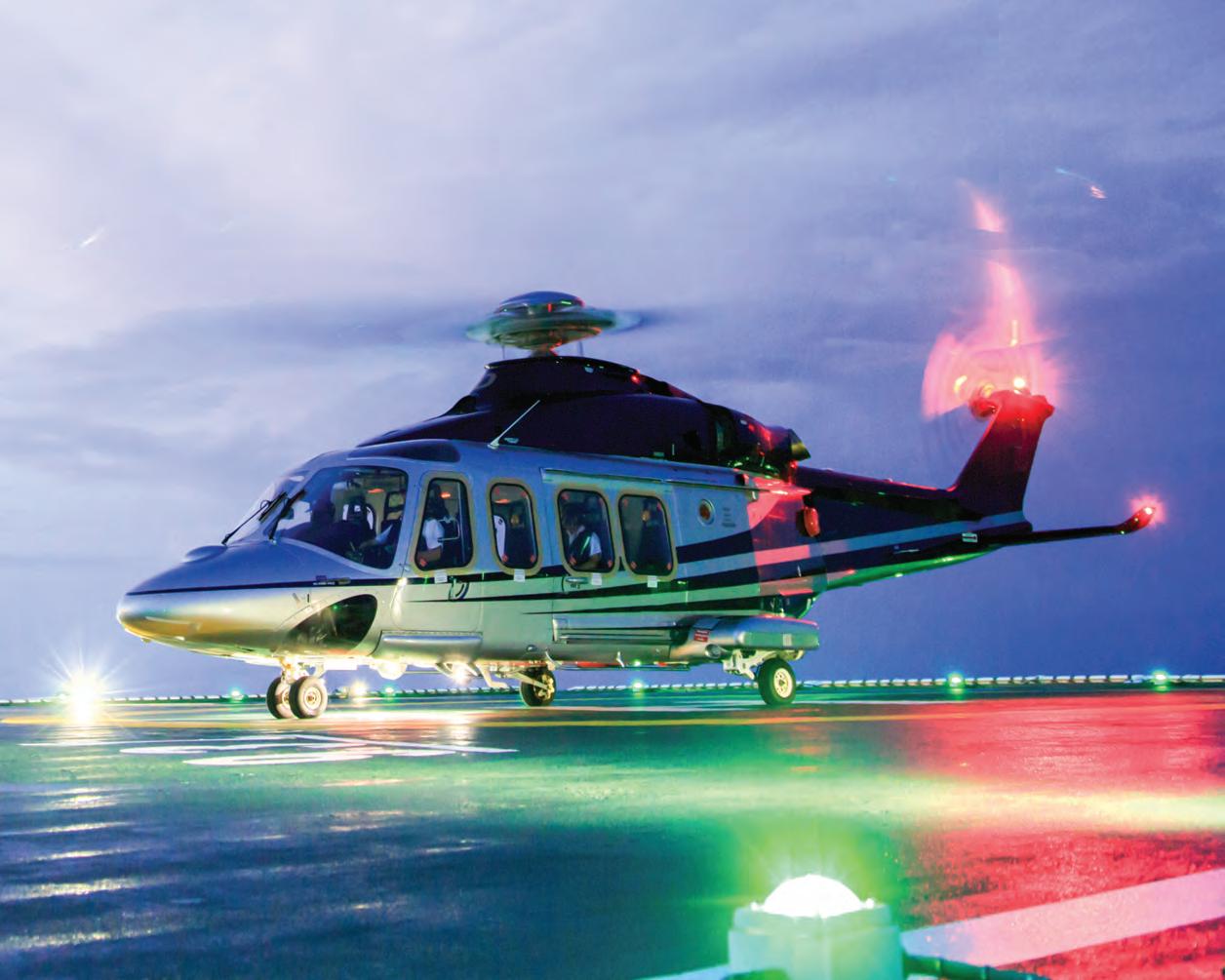

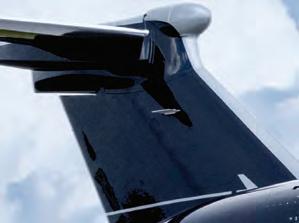







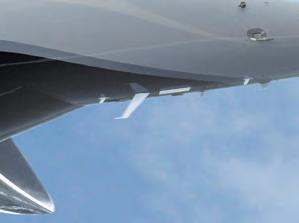

20
Special Report: Wi-Fi in the sky: better, faster, getting cheaper


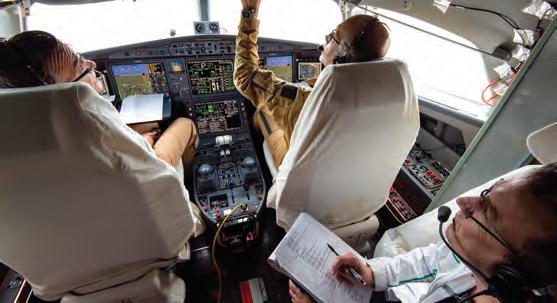
ENHAN C EDTRAININ G
For 10+ years, FlightSafety International (FSI) and Pratt & Whitney Canada (P&WC) have collaborated to develop, improve, and implement cutting-edge technology for aviation maintenance professionals around the world. Together, we are now introducing virtual engine training that provides real-time, interactive animation of the engine. This allows technicians to take their skills to new heights by exploring engines down to the component level. The result—enhanced engine-specific understanding and elite performance in the sky.

Prepare to lead with FSI.
+1 201.584.8262 | FlightSafety.com
Envirotech Vehicles (EVT) chose the NBAA Schedulers and Dispatchers Conference (SDC)—held in late January in Nashville, Tennessee—as the venue for the public debut of its all-electric refueler. The recently-completed first production model of the 900-gallon capacity avgas truck was displayed at SDC2023, marking not only the first time an all-electric refueler was displayed on the SDC show floor but also for any first-production model to be on display there.
Arkansas-based Envirotech, which manufactures a range of electric commercial vehicle chassis, partne red with aviation equipment manufacturer Garsite, which outfits the refuelers. The one displayed at the Music City Center was delivered to Atlantic Aviation immediately following the show.
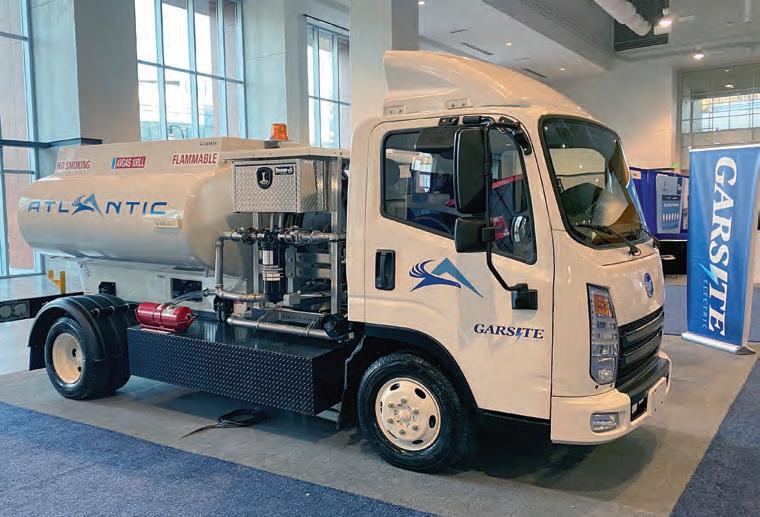
The vehicle requires no special infrastructure for charging and, according to Garsit e director of customer technical support Mike McCarthy, the vehicle’s no-maintenance lithium-iron-phosphate batteries will provide endurance for a full day’s fueling and then still drive 50 miles before recharging.
Meanwhile, the refueler’s pump is rated for a 20-gallon-per-minute flow capacity, and while that is satisfactory for the smaller volumes typical in avgas fuelings, Garsite is currently working on integrating the higher-capacity battery and pump that would be needed for jet-A fueling.
Sue Emry, EVT’s executive v-p, told AIN that her company will provide a larger electric vehicle frame later this year to Garsite, which expects to complete it as a 5,000-gallon jet-A refueler. z
Gulfstream Aerospace fell short of its projected 124 aircraft deliveries last year, handing over 120 jets as three were deferred from the fourth quarter to early this year. They included 96 large-cabin jets and 24 midsize G280s, up from 119 units (103 large cabin and 16 G280s) in 2021. Parent company General Dynamics is projecting 145 Gulfstream deliveries this year, with aerospace division revenues expected to reach $10.4 billion. General Dynamics also reaffirmed the forecast for 170 aircraft shipments next year. Aerospace backlog was $19.516 billion at the end of 2022.
Super Bowl LVII in Glendale, Arizona, on February 12 provided a bonanza in business aviation activity to the area’s airports and FBOs. According to aircraft tracking provider FlightAware, between Thursday, February 9 and the day after the game, the eight airports in the region saw more than 1,700 business aircraft arrivals. According to Argus International TraqPak data, there was an exodus of private aircraft following the game—from 9 p.m. local time until midnight, there were more than 900 departures.
Wipaire has introduced the Aurora Collection of interiors for the Cessna 208 Caravan and Grand Caravan EX. The nine cabin designs, each inspired by a body of water, feature upgraded seating, tailored leather, and handcrafted cabinetry. Seats feature topgrain leather upholstery, adjustable inboard armrests, side tables with leather writing inserts, concealed under-seat storage, and full swivel and recline functions. The wood-veneer cabinetry is coordinated with lower sidewall fabric and wool carpet.


 BY JERRY SIEBENMARK
BY JERRY SIEBENMARK
Despite ongoing supply-chain issues, Textron Aviation saw more jet and turboprop deliveries, revenue, and profit in the fourth quarter, parent company Textron reported. Cessna Citation deliveries during the quarter totaled 52 versus 46 in the same period a year earlier while turboprop deliveries— Cessna Caravans, Beechcraft King Airs, and Cessna SkyCouriers—rose to 47, up from 43 in late 2021.
In the fourth quarter, Textron Aviation earned $1.6 billion in revenue, a $223 million year -over-year increase. Profit increased by $32 million from fourthquarter 2021 to $169 million. Backlog was $6.4 billion at the end of 2022, up from $4.1 billion in late 2021.
Textron CEO Scott Donnelly admitted on an earnings call with analysts that the supply chain affected the number of aircraft Textron Aviation delivered. “We were a few hundred million dollars light versus our initial guide, based on the fact that we continue to see supply-chain challenges,” he said. “I think we’ve had a number of
suppliers that were challenged [but] are getting better. But you always have a couple out there that are still struggling. We kind of anticipated that in the back half of the year…There’s still going to be supplychain challe nges along the way, but we think we’ve taken that into proper consideration in terms of the 2023 guide.”
While various reports have discussed signs of an economic slowdown and waning new aircraft sales, Donnelly said customer demand for Textron Aviation’s aircraft across the product line is unchanged.
“I think our order rate in the fourth quarter was consistent with the third quarter— it remains quite healthy,” he said. A slight increase in used available aircraft isn’t necessarily a sign of overall slowing sales when those aircraft that are listed could be types that are less popular and older than other aircraft on the used market, Donnelly added. “We think obviously the market has been very strong. We haven’t seen a material change in the level of activity.” z
Bombardier is preparing for a nearly 12 percent ramp-up in deliveries in 2023 to an anticipated 138 aircraft and forecasting revenues to increase by more than 10 percent, to $7.6 billion. Bombardier president and CEO Éric Martel said the the production targets take into account risks with the supply chain and a potential recession, but he pointed out that its $14.8 billion backlog—which grew by $2.6 billion last year—is “super solid.” As for 2022, the company delivered 123 business jets and revenues finished at $6.9 billion. Last year’s deliveries were three aircraft more than in 2021, while revenues were up by 14 percent year-over-year from just under $6.1 billion. Adjusted EBITDA soared to $930 million, a 45 percent increase.
Beta Technologies made a test flight of its six-seat, all-electric Alia-250 EVA eVTOL at the Westchester County Airport (KHPN) in White Plains, New York, on February 14. The flight, which was performed in cooperation with Blade Air Mobility, was the first of an eVTOL aircraft in the New York City metropolitan area. The Alia-250 flew alongside a conventional helicopter before pulling away for a second pass above the airport to highlight the eVTOL’s comparative quietness. Beta claims its noise profile is one-tenth that of a conventional helicopter. In April 2021, Blade agreed to purchase up to 20 passenger-configured Alia-250s for its network of operators.
The city of Santa Monica has taken the next steps to shutter California’s Santa Monica Airport (KSMO) later this decade with a recent city council approval of a process to review future potential land uses once KSMO closes in 2028.
Fleet operators know that a grounded aircraft costs money and degrades service levels. Fortunately, Avidyne’s SBAS-capable FMS/GPS systems for helicopters are designed to not only keep your fleet up and running, but operating with technology that will last for years to come.


• IFD100 iPad™ App: Big Glass for your cockpit
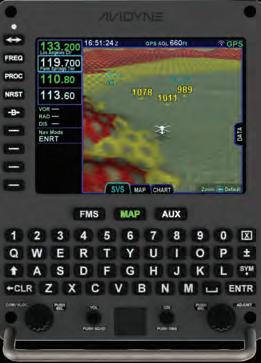

• Built in WiFi/Bluetooth®
• Synthetic Vision with 3D terrain, obstacles and traffic
• 3-arc-second Terrain & Powerline database
• Glove-friendly touchscreen plus knobs & buttons
• Designed to fit your panel and your mission
avidyne.com/heli
photo credit to @temscohelicopters IFD5 - Series IFD4 - Series Avidyne HeliosAIN Media Group is pleased to announce the hiring of Ruben Kempeneer as president. Kempeneer comes to AIN from aviation analytics business Cirium.

He joined Cirium in January 2017 as v-p of sales for Asia and was based in Singapore.
Kempeneer served on Cirium’s executive leadership team as head of sales for the Americas since September 2018.
RUBEN KEMPENEER PRESIDENTWith more than 20 years of senior leadership in events, publishing, data, and analytics across five continents, Kempeneer is passionate about developing people and building companies and teams that outperform their market peers.
Kempeneer reports to AIN’s newly-formed board of directors. Wilson Leach, Jennifer Leach English, and Dave Leach will serve as directors. Wilson will assume the role of chairman emeritus, maintaining his pulse on the business and the industry, while Jennifer will continue in her role as editorial director of Business Jet Traveler and Dave will be transitioning from his current position as COO to executive chairman.
“We are committed to keeping the AIN Media Group in the Leach family,” said Wilson Leach. “The announced board formation, family role adjustments, and hiring of Ruben have been well considered and planned out over the last two years. We feel incredibly positive about the future of this business as an independently owned media company serving the global aviation industry for many years to come.” z
Driven by sustained demand for business aircraft travel, London-area Farnborough Airport logged 33,120 takeoffs and landings last year—up from 26,007 in 2021 and 32,366 in its previous record year of 2019. Airport CEO Simon Geere expects the upward trend to continue this year. The 2022 tally gives Farnborough a 31 percent share of business aircraft movements for London-area airports. Geere described last year’s performance as “impressive” and attributes the increase in movements to the “post-Covid bounce.”
The FAA has finalized the first aircraftspecific standardized training curriculum for Part 135. The curriculum—for the Gulfstream V—was issued in October. In what is anticipated to be the first of a series for specific aircraft, the curriculum is a voluntary program designed to provide a standardized approach to training at Part 142 centers. A key feature is that the programs are portable, which addresses the issue of charter operators having to send pilots to initial training for the same model of aircraft for each operator they fly for, even if the pilots are current in that aircraft.
JumpHub has introduced a non-revenue flight benefits program for Part 135 operators and flight crews. JumpHub offers crews of its operator network “as available” access to empty leg flights aboard all operator members’ aircraft. Positioning flights comprise 25 to 40 percent of all charter cycles, the company said. Using a closed system, JumpHub permits crewmembers at participating operators to search, request, and get pre-approved to ride on unsold empty legs. Each operator contributes and benefits in proportion to the size of their operation.


U.S.-registered business jets suffered no fatal accidents last year, according to data compiled by AIN . That is a significant improvement from 2021 when 23 p eople lost their lives in six (all Part 91) accidents involving N-numbered business jets.
Meanwhile, non-U.S.-registered business jets were involved in four fatal accidents last year, resulting in 16 deaths versus a single fatality from one crash in 2021.
On July 1, 2022, an Argentina-registered Learjet 35A crashed on takeoff from Río
continues on page 60
Business aircraft flight activity in North America last year surged by 5.1 percent over 2021 but traffic remained largely flat for the last three quarters of 2022, according to Argus International’s year-end analysis. Traffic continued to surge in the first quarter of 2022, up 23.2 percent year-over-year, but the last nine months of the year combined for just a 0.4 percent gain. This was still well above pre-pandemic levels, up 15.2 percent from 2019. Part 135 began to see the jump in operations wane, ending the year at a 1.3 percent increase over 2021. Fractional operations saw a 6.6 percent increase, and Part 91 operations improved by 7.9 percent.
ACCIDENTS/INCIDENTS WORLDWIDE (2022 VS 2021)
Bombardier has realigned its senior leadership team. Jean-Christophe Gallagher is now executive v-p of aircraft sales and Bombardier Defense. Paul Sislian was promoted to executive v-p of Bombardier aftermarket services and strategy. David Murray was elevated to executive v-p of manufacturing, IT, and Bombardier operational excellence system. Éric Filion has taken the role of executive v-p of programs and supply chain, and Michel Ouellette, a 33-year company veteran, will lead engineering and product development as executive v-p until his planned retirement in June.
minor damage to destruction and/or injuries. Also, some incidents ultimately get upgraded to accident status during the investigative process.
Continuing its push for small operators to adopt flight data monitoring (FDM) programs, the NTSB released a video highlighting the benefits and possible solutions for those aircraft operators. The 30-minute video provides a synopsis of a roundtable the Safety Board held entitled “Practical Flight Data Monitoring Solutions for Small Operators.” The goal of the roundtable was to show how small and medium-size operators can use data to prevent crashes and improve safety.
tables show “incidents” as well as “accidents” to distinguish mishaps based on their degree of severity. Investigators often draw fine distinctions between the two events, but, typically, incidents result in minor or no damage and their investigations are sometimes delegated to local officials. Accidents are events that range from
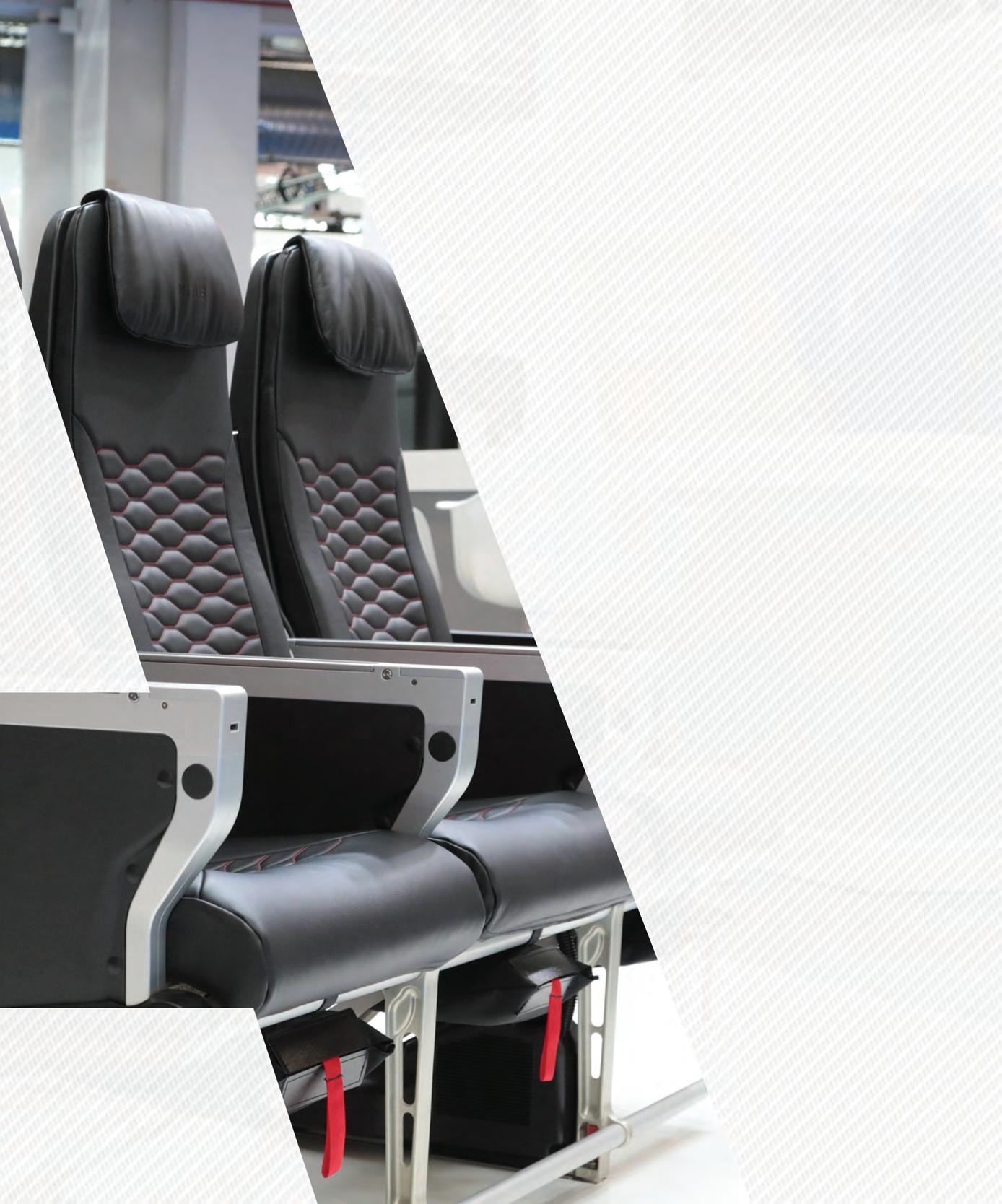

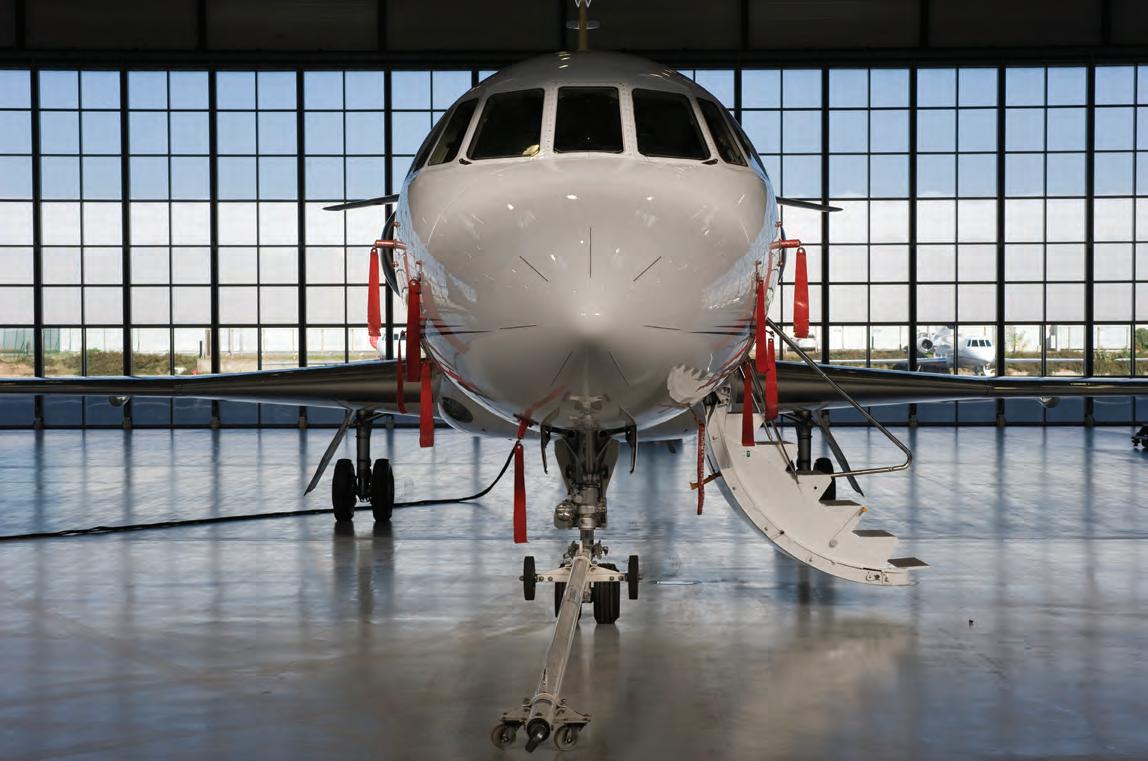 BY CURT EPSTEIN
BY CURT EPSTEIN
There is a saying in the aviation business that if you’ve seen one airport…you’ve seen one airport. There may be truth in that axiom, but not when you’re talking about a shortage of hangar space among the top 200 or so airports frequented by business aviation passengers.
The problem is not new to the industry, but it has become more acute over time for multiple reasons, the first being simply that large markets tend to attract large amounts of business aircraft.
“The problem is people want to be in Los Angeles, Teterboro, Miami, DFW—they
want to be in specific places,” said Milo Zonka, vice president of real estate with Florida-based FBO operator and hangar developer Sheltair. “Florida, in general, is definitely constrained—everything from Miami, Fort Lauderdale, Naples, Orlando, Tampa, Jacksonville is full. Of course, we’re really talking about those hangars that can accommodate anything. If you are scrounging for a 16- to 18-foot hangar for a light jet, you might be able to find something in a secondary market.”
Another factor is the longevity of business jets. The age of the business jet fleet
has increased as aircraft that in past would have been put out to pasture have gained new value in the post-Covid private aviation boom.
“There is so much demand for private jets now that even if you have a 30-yearold jet that otherwise would have been retired, as long as it is safe and airworthy, it makes sense to keep it in service,” said Tal Keinan, CEO of private hangar developer Sky Harbour. “There is also a technology component. Jets get better over time and live longer over time, which speaks to a swelling population.”
While aircraft are lingering longer, the jet population continues to grow as OEMs meet demand with new aircraft that will also compete for the existing hangar space.

Last year saw 712 business jet deliveries worldwide, with the U.S. accounting for nearly 70 percent of the market or more than 400 new aircraft.
Sheltair’s Zonka explained the math: “You take 400 airplanes and the average [hangar space needed] between light, mid, and large jets is 5,000 square feet each, you are talking two million square feet of hangars that have to be built just to accommodate what came off the line,” he said. “Even if you are only talking a million square feet, that is thirty-three 30,000-square-foot hangars, and there are probably only 10 or 15 being built at the moment.”
Given current construction prices, Zonka estimates the cost for each at approximately $9 million. “But you are
















dropping $9 million 30 times just to accommodate this year’s deliveries, and then you have to do it again next year.”
The aircraft themselves may be the largest factor. “There is a drive toward larger air craft and larger hangars so that puts pressure on where these aircraft live and go,” said David Best, Jet Aviation’s senior v-p of regional operations for the Americas. “We want to build facilities that are relevant today, but also for the future.”


In 1996, the largest aircraft in Bombardier’s product lineup was the Challenger 604, which has a ground footprint of 4,485 sq ft. That year, the Canadian airframer introduced the Global Express as its new flagship. The long-range business jet more than doubled the 604’s footprint at 9,400 sq ft. “That was only 27 years ago, which in the span of aviation infrastructure isn’t a very long time

DAVID BEST
JET AVIATION SENIOR V-P, AMERICAS
There is a drive toward larger aircraft and larger hangars so that puts pressure on where these aircraft live and go...
when you look at 35-year [FBO] leases,” noted Doug Wilson, president and senior partner of consultancy FBO Partners.

Since that time, Bombardier has delivered more than 800 legacy Globals, equating to more than 7.5 million sq ft of hangar space. It has since delivered at least 100 of the follow-on Global 7500, which is even larger with a footprint of 11,648 sq ft.
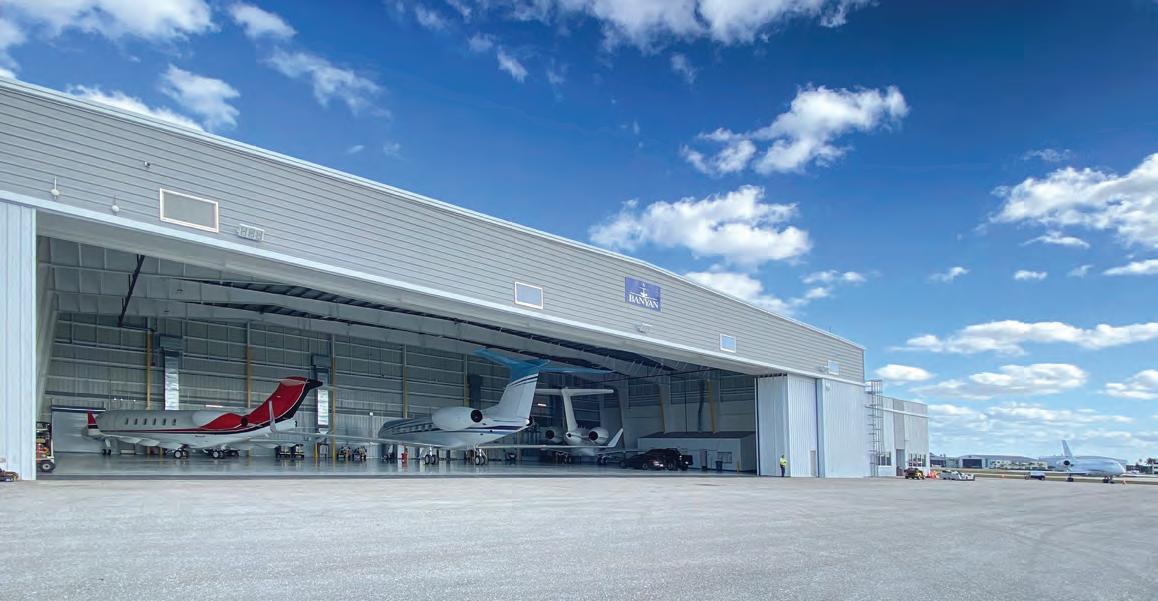
Gulfstream has seen similar aircraft evolution. In 1996, its GIV-SP took up 6,942 sq ft of hangar space while today’s G650 is more than 3,000 sq ft larger at 10,000 sq ft. Dassault’s under-development Falcon 10X will be even larger at 12,100 sq ft.
It is not just their footprints that are a concern but their heights as well, with the latest ultra-long-range business jets requiring door heights of 28 feet. While that has become a standard these days in the high-traffic areas of the Northeast, Florida, Texas, and California, elsewhere they are still generally the exception.
As Keinan explained, “You’ve got plenty of hangars—especially in the higher-end locations such as the New York area—that have 28-foot-high doors but most of the installed base in the country is 24 feet and down because when these hangars were built 30 to 40 years ago, that would have accommodated the tallest business jets.”
He calculates that since 2010, there has been an 81 percent increase in the square footage of aircraft with a tail height of more than 24 feet for a total of 16.6 million sq ft.
“Back in the late 1980s, your ideal hangar might have been 10,000 square feet and it met your GIII s and GIVs of the day, but today that same hangar is probably at a minimum of 15,000 square feet as an ideal, give n the size of the aircraft,” said Curt Castagna, president and CEO of the National Air Transportation Association (NATA) as well as head of hangar de veloper and operator Aeroplex Group Partners. “Depending on the type of operations you are having, meaning Part 91 vs 135, your ideal hangar might be 30,000 sq
Depending on the type of operations you are having, meaning Part 91 vs 135, your ideal hangar might be 30,000 sq ft-plus...
ft-plus to accommodate nesting of multiple airplanes.”
He noted that in the Los Angeles area alone, companies have added more than half a million sq ft of hangar space over the past several years, all of which is now fully occupied.
“I think you can say demand is definitely outstripping supply in the major metropolitan areas, and then in the secondary markets, there might be a little bit of capacity, just not the right capacity, the 28-foothigh doors,” Zonka told AIN . “We’re full in every location and it’s a mad dance in South Florida, for example. It’s a daily search for aircraft that are either new to the owner or the owner is relocating.”
Given that level of demand, one would imagine new hangars would be sprouting like mushrooms. Part of virtually every lease award or renewal is a capital infrastructure requirement by the airport. Multimillion-dollar investments such as hangars are typically made early on in the lease to provide the longest time possible to amortize the costs.
“I think what is important to realize is hangar development goes in cycles with the ground leases and the economy, and so I would say in the late 1980s and early 1990s there were a lot of 30-year leases that went into play for airport developments around the country,” said Castagna. “Now we are coming full circle again 30-something years later where a lot of these developments are coming up to where they are reverting back to airports.”
Those airport sponsors can choose to offer the existing FBOs a lease renewal, put the property up for a request-for-proposal contest to attract other operators, or simply choose to take over the operation itself. “If you think about it in the context of the lease cycle, if an FBO built hangars with a lease that they got in, say, 2000, they’ve already exhausted 22 years on their lease, and there are only another 10 or so years left,” Wilson told AIN. “Are they going to invest in a brand new 28-foot-door hangar
To help give FBOs the best use of their limited hangar resources, FBO Partners has developed Hangar IT, a software program designed to allow hangar keepers to swiftly and accurately determine their hangar space availability at any given moment. At its most basic, the program allows FBOs to enter all their tenant contracts into a database where the system can automatically flag ending leases for renewals and/or pricing adjustments. The system feeds these alerts to the company’s accounting system for further action.

The second function determines the most accurate occupancy in the operator’s hangars. “That is performed by capturing all your existing tenants from your lease documentation,” explained FBO Partners president and managing partner Doug Wilson. “Those tail numbers go into the system, which automatically recognizes the exact aircraft type and assigns the correct square footage to the aircraft.” Through a feature called “Roll Call,” aircraft can be assigned to one of the FBO’s hangars. Each time line service technicians enter that hangar to move an aircraft, they will scan a QR code on the door, which will bring up the hangar roster. They will then
enter the tail number of the aircraft they are moving, and the program will automatically deduct the correct amount of space in the hangar and calculate the level of occupancy, thus allowing the FBO to immediately know how much space it can offer to transient aircraft. Wilson noted that the system is in beta testing with an eye toward full release later this year.
A third function, once the patent-pending program gains market acceptance, will be a marketplace where hangar operators can post their vacant space, allowing flight departments to reserve and pay for guaranteed transient hangar space ahead of time rather than simply being placed on a waiting list.
C.E.when the airport won’t necessarily give them an extension to amortize it?”
FBOs are building hangars when they deem it fiscally prudent to do so, but in many cases finding places to put those hangars is a problem. “The whole other problem when you start talking to airports like Teterboro is they don’t have any land left,” said Zonka. “They are running out of dirt.”
That has caused aircraft operators to seek out secondary and tertiary airports in more crowded regions. Clay Lacy Aviation is building an FBO featuring a quartet of 40,000sq-ft hangars at Connecticut’s Waterbury-Oxford Airport (KOXC).
“There’s been a lot of discussion about new hangars being built in White Plains, new hangars being built in Teterboro, and other airports in the surrounding area, but this is really happening,” said David “Buddy” Blackburn, Clay Lacy’s senior v-p for its KOXC FBO operations. “The buildings are going up, so that’s a big deal for the Northeast for sure.”
At those airports where development (or redevelopment) is possible, hangar operators are encountering more headwinds resulting from the Covid-induced changes in the economy.
“We finished a hangar in the Los Angeles area in 2018 that between hangar, office, and terminal space was roughly 45,000 square feet, and that hangar was about $7.2 million,” Castagna told AIN . “That hangar around the middle of 2022 might have been around $11 million to $13 million just because of the construction costs—steel and labor and the other pressures on the project—which all go into the metric of evaluating the return on investment and the lease term.”
Those rising costs are indeed playing a role in the decisions to launch construction, according to some companies. “We’ve got half a billion dollars in projects that are on our books right now that we want
to turn dirt on,” Zonka said. “[But] they are in markets that can’t support the rent because the construction is so expensive.”
Castagna added that because of the increasing costs, the end user is going to bear the burden in markets where existing rents are so low that it is tough for FBOs to make financially sustainable developments.
the point where you put the shovel in the ground, so we’ve had to track costs as we go along and make sure we are constantly updating our pricing structures so we understand what the total cost of the build is.” He added that pricing on construction materials such as steel can vary depending on when the order is placed.
“We typically do a fixed firm price for contractors at the time we ink the deal so once we get to the permitting stage then you know exactly what your final costs are.”
“Against the constraints of infrastructure development because of lease t erms and obviously the cost, we have seen the market responding with higher per-squarefoot rates and a greater focus on the real estate as a function of the FBO business,” said Wilson. “That was thrown into the most contrast during Covid.”
Sky Harbour, a hangar complex builder and operator with facilities in Houston and Nashville, recently opened its third location at Miami Opa-locka Executive Airport. Among the three facilities, it has brought nearly 400,000 sq ft of high-end hangar space online, with a further 300,000 sq ft of aircraft shelter to open by the end of this year in Denver and Phoenix, followed in early 2024 by 170,000 sq ft in Dallas.
According to CEO Keinan, the company plans to develop millions of square feet of new capacity. It has vertically integrated, manufacturing its own hangar components to speed construction and better control its supply chain, yet it too has been affected by the recent price increases in steel and labor, which affect rents that are charged as companies seek to make back their investments.
“Anytime you build a hangar, it never happens overnight,” said Chuck Suma, COO of the Million Air FBO chain. “It’s usually a 12- to 18-month project to get to
On April 13, 2020, business aviation reached its low point, off by 75 pe rcent from normal activity. “But pretty much every based tenant paid their rent because it’s really hard to get a hangar once you’ve lost your spot,” Wilson added.
Another change wrought by Covid was the desire by high-net-worth people to retreat from crowded urban areas to more rural locations that typically did not see much business aircraft traffic and lacked the infrastructure to accommodate it.
“Ten years ago, if you had said ‘Bozeman, Montana,’ we would have said, ‘Where’s that?’” quipped Best. “Now we’re putting a 40,000-square-foot hangar there and we’ve got strong demand from our customers to be there.”
Million Air’s Suma described it as a change in patterns, where customers are now heading to these vacation destinations earlier than they used to and staying longer as well. “There is still the resort traffic, but a lot of what we are seeing with the large aircraft coming in are the people who own homes there.” z
It’s usually a 12- to 18-month project to get to the point where you put the shovel in the ground, so we’ve had to track costs as we go along and make sure we are constantly updating our pricing structures so we understand what the total cost of the build is.
GEARED UP
Portable ADS-B receivers just keep getting better, and ForeFlight’s Sentry series is a good example. Since the FAA created the 978 MHz automatic dependent surveillance-broadcast (ADS-B) network and added ADS-B In to incentivize pilots to equip with ADS-B Out transponders, the capabilities of portable ADS-B In receivers have multiplied.
The latest Sentry Plus doesn’t change the basics of ADS-B In, but it adds features that make it a more useful device including battery life of more than 18 hours, highperformance flight data recorder, g-meter, and automatic power on/off setting. The new features accompany a 1.3-inch OLED display, which shows battery level, carbon monoxide (CO) status, acceleration (g-load), groundspeed, and GPS accuracy.
ADS-B In features are what most pilots expect to find on a modern receiver like the Sentry Plus, such as dual-band ADS-B In TIS-B traffic, free FIS-B weather, WAAS GPS, and attitude heading and reference system (AHRS) pitch and bank information.
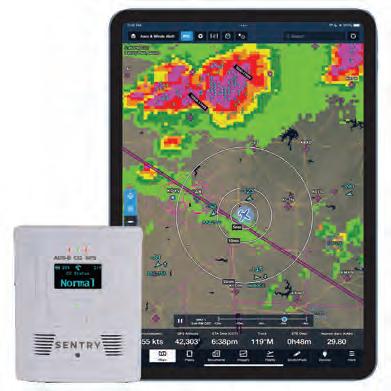

I’ve been flying with the Sentry Plus for more than six months, and it’s a definite improvement on the earlier $599 Sentry, which is still available. Both have the CO sensor, dual-band ADS-B In, and AHRS, but the additional features resulted in the larger Sentry plus, which weighs almost twice as much and is roughly an inch wider and taller. One benefit of the increased size is a larger battery, and the Sentry Plus battery does last far longer.
Track logging is automatically started each time the Sentry Plus is switched on. The flight data recorder stores track, altitude, pitch and bank, groundspeed, and g-load information. Flights can be viewed in ForeFlight’s track logs view or exported
automatically for post-flight analysis in other programs such as CloudAhoy. Although it doesn’t include air data other than pressure altitude from the Sentry Plus’s altitude sensor, the track logs are fairly accurate, within the limitations of the available recorded informa tion. Both pressure altitude and GPS altitude are available, and users can receive alerts from ForeFlight’s automatic cabin pressure advisor when cabin altitude exceeds 12,000 or 25,000 feet.
The Sentry Plus’s GPS receiver is accurate to within one meter and features both U.S. GPS and European Galileo sensors. If the U.S. GPS network is jammed, which happens fairly frequently during military testing, the receiver will automatically switch to the Galileo constellation.
Here’s one example of what the current tight used-bizjet market has wrought: an eight-passenger 1984 Cessna Citation II— with almost run-out engines—is for sale for just $299,000. That equates to monthly payments of only $1,900—about what you’d pay to rent an upscale one-bedroom apartment in Albuquerque, New Mexico.

The former Customs and Border Protection aircraft has 11,800 hours of total time on the airframe and a couple hundred hours left on the engines. It comes with a stock executive interior—but it’s not installed. You’ll also need to replace the windshield. The panel has minimal updates—a Garmin GNS 530 navcom and old radar—and could stand a few more: there is no ADS-B and the altimeter is not RVSM-certified.
A few years ago, such an airplane would have been sent to a boneyard and parted out. Or it might be acquired for a oneshot smuggling mission or sent to a country where maintenance inspections are
unknown concepts. But in February, it sat in a Dexter, Michigan hangar where it was offered for sale by Herron Aviation, after having been picked up at a government auction in Florida last year. The aircraft recently made it through the months-long FAA registration gauntlet and, at this writing, had been on the market for less than a week. In a normal market, a buyer wouldn’t look twice.
Yet, over just a few days, company principal Brian Herron received more than 30 calls fr om potential buyers. By the time you read this, the aircraft likely will have been sold for close to the asking price.
Herron specializes in acquiring and remarketing what he calls “variable” aircraft. And demand for those aircraft is booming, with customers sometimes eschewing pre-buy inspections and even snapping up aircraft with missing logs. “In a regular market, you wouldn’t see much demand for Citation IIs, but they’re selling,” said Herron.
That is, when you can find one. Many people who have them are hanging onto them, said Phil Stearns, director of sales and marketing for Stevens Aviation, a maintenance and modification pr ovider for Citations. Stearns calls the Citation II the “family truckster,” a reference to a fictitious, aesthetically challenged station wagon featured in the 1983 comedy, National Lampoon’s Vacation.
“The value of the aircraft is basically the time left on the motors,” said Stearns. But increasingly, people are keeping them. “If you’re in the aircraft, it fits your mission.
In a regular market, you wouldn’t see much demand for Citation IIs, but they’re selling.
It’s paid for at this point in its life and likely [fully depreciated]. It’s the family truckster and you’re going to keep running this thing. You can turn up $700,000 or $800,000 for a set of motors when it comes time for that thing. Or you could try and find a [newer] airplane—and good luck to you. It’s just a goofy market right now.”
And that market is keeping the Citation II relevant.
Cessna produced the airplane between 1978 and 2006 in four main variants—II, IISP, SII, and Bravo—and several aftermarket remanufacturing/re-engine programs were available—the Super II/Super S-II from Sierra Industries and Clifford Series 550 from Clifford Development Group.
Altogether, nearly 1,200 Citation 550 family series aircraft were built. With its good short-runway performance—less than 4,000 feet required in most situations—and better comparable speed, the Citation II did more than any other business jet to substantially reduce the market appeal of twin-turboprop business aircraft.
In its wake, one by one production ended on business turboprop twins made by Mitsubishi, Aero Commander, Piper, and Fairchild/Swearingen. Only the Beechcraft King Air remained in production. With a cruising speed of 385 knots, the aircraft was only marginally faster than the propeller aircraft on most trips under 500 nm but cruised at higher altitudes (ceiling 43,000 feet) and provided a cabin with less vibration. There was also the cache and appeal of jet travel.
The impact of the Citation II family on worldwide business aviation cannot be understated, either for its maker or its customers. Early on, it brought dozens of Part 135 charter operators into the jet age. The S/II, formed the backbone of the initial fleet of fractional ownership pioneer NetJets in the 1980s and 1990s, and numerous
smaller fractional and shared ownership operators. And, its design was morphed into numerous succeeding models—the Citation V, Ultra, Excel, and XLS/XLS+— which collectively account for more than 1,500 aircraft.
Within the entire Citation II lineage, the original Citation II, manufactured between 1978 and 1994, has been the most popular. It features a three-foot, nine-inch fuselage stretch and a three-foot, six-inch cabin extension from the Citation I, creating room for two extra passengers, and a wider wingspan, allowing for 198 gallons of additional fuel. Compared with the Citation I engines, the II’s Pratt & Whitney JT15D-4s each deliver 600 pounds of additional thrust. Cruising at 375 knots, the II has a 1,200-nm range with IFR reserves. Real-world cruising speed is closer to 350 knots.
tall. With seats full, passengers need to pack light. External baggage hold is 41 cu ft. Internal stowage is 36 cu ft.
The II was certified to the more stringent Part 25 standards and requires two pilots. However, the II SP (Model 551, produced between 1978 and 1987) can be flown single-pilot. Requiring a different type rating, the II SP aircraft has a slightly different instrument panel and an 800-pounds-lighter maximum takeoff weight, down to 12,500 pounds, bringing it into Part 23 parameters.
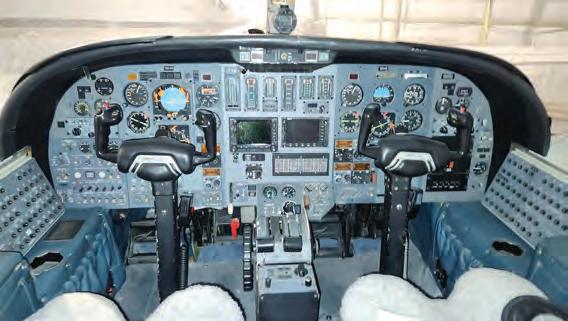
The II’s straight-leg, wide-stance main landing gear is not forgiving of ham-handed landings and the turning radius on the ramp is a bit wider than that of its contemporaries.
The S/II (produced 1984-1988) can also be flown single-pilot. With tweaked engines and a reworked wing that can hold an extra 120 gallons of fuel, the S/II offers a maximum cruise speed of 400 knots and a range of almost 2,000 nm.
Required maintenance inspections are pricey events. Phase V must be completed every three years or 1,200 hours . It can easily cost more than what you paid for the airplane. Similarly, TBO for the Pratts is 3,500 hours; ho wever, that can be extended to 5,200 hours, “on condition,” for engines enrolled in approved monitoring and inspection programs.
Typical cabin layouts feature a two-place, side-facing divan opposite the aircraft entry door followed by six individual executive seats, the first four of which arranged in a facing club configuration. Between the first four and last two seats, the wing spar also intrudes into the cabin aisle, so watch your step. A blue water lav with a privacy door is behind the seats. By contemporary standards, the cabin is not capacious, measuring 15 feet, nine inches long, four feet, eight inches wide, and four feet, seven inches
The Sierra and Clifford aftermarket modification programs replaced the Pratt engines with those from Williams, boosting cruise speed and takeoff weight while cutting climb times and fuel consumption. Priced from $1.6 million to more than $2 million, they long ago stopped making sense for a market where the majority of inventory for sale is priced under $1.5 million; however, aircraft so equipped command a premium price.
And, then again, it’s a “goofy market.” Because it is, the flying “family truckster” soldiers on. z
 BY MATT THURBER
BY MATT THURBER
For many years, the available choices for airborne connectivity systems were limited. Few products were made for smaller air craft, and the costs of so-called “WiFi” systems were prohibitive, affordable mostly for larger business jets, although the se rvice costs were equally as expensive.
That is finally changing, with new competitors entering the airborne connectivity market, offering more coverage, new equipment options, technologically advanced antennas, and finally, lower service prices.
To get a handle on the connectivity market, it’s helpful to consider the available networks and then look at equipment and
services. The network makes the connectivity possible, and each network has limitations that buyers should know about before making a purchase decision.
This article is limited to connectivity for non-airline business aviation and smaller aircraft, including helicopters. Not all manufacturers provided pricing information.
There are two broad network categories that serve the aviation market, satellite communications (satcom) and air-to-ground (ATG).
Presently, there are five satcom networks serving business aviation, although two are either just starting or about to begin. Within the satcom arena, there are differences
between the altitudes where satellites orbit and also the kinds of service they can provide.
The two key orbital planes for aviation connectivity are geostationary (GEO) and low earth orbit (LEO). GEO satellites, which orbit at more than 22,000 miles above the earth, can deliver high-speed
service globally, although existing networks don’t cover polar regions. That will change, however, with Inmarsat’s plan to fill those gaps. LEO satellites vary in data speed, and it takes many more satellites to deliver service from much lower altitudes, but LEO networks also provide full global
coverage and lower latency (the time needed for signals to travel).
An advantage held by Iridium’s L-band frequency is that it is the sole LEO provider of safety service, which offers reliable communications with air traffic control (ATC) over oceans and remote areas where ground stations don’t exist. Inmarsat’s GEO SwiftBroadband L-band service is also safety service-qualified, but it doesn’t cover the poles. Ku- and Ka-band GEO satcom signals can’t penetrate moisture very well and that is why they don’t qualify for ATC safety service, but they can provide high-speed service.
Both Iridium and SwiftBroadband operate in L-band frequencies, which can penetrate moisture reliably and thus aren’t hobbled by rain and moisture-laden clouds. Iridium and SwiftBroadband don’t offer enough capacity to permit video streaming, so they are better suited to messaging, data upload (cockpit weather) and
download (aircraft and engine telematics), and voice calls.
For data-hungry passengers who want to replicate their office and entertainment options while airborne, GEO networks have for many years been the only option. Speeds are high enough for video streaming, video meetings, heavy emailing with at tachments, internet voice and video calls, and any kind of messaging. Of course, the cost of service goes up as the amount of data consumed grows, but that is the nature of airborne connectivity.
However, nascent LEO networks from SpaceX (Starlink) and OneWeb promise high speeds and sufficient capacity f or video streaming, and those products are coming.
LEO providers often cite the lower latency of their satellites as a factor in providing speedy service, but that isn’t necessarily the case, according to James

Person, Viasat director of business development and strategy. “Most people don’t realize that the number one cause of latency in any wireless or shared network is lack of capacity.”
An example of this is when trying to send a video from a crowded event where users are overwhelming the cellphone network. “They don’t have enough capacity,” he explained, adding that video conferencing and voice calling already work well on GEO networks. However, some latency-sensitive applications like rapid securities trading or first-person shooter games lose out to ground-based fiber networks, and that is the same with LEO networks.
“We deal with latency by having massive amounts of capacity,” he said. “A wellengineered GEO network can do anything LEO can do from a latency standpoint, and the key is capacity.”
The main aviation GEO satcom constellations are operated by Inmarsat (Ku-, Ka-, L-band), Viasat (Ku-, Ka-band), and IntelSat (Ku-band).
Inmarsat has been serving the aviation satcom market for more than three decades, and it continues to add capacity to its GEO network. This year, Inmarsat will launch a second satellite in its I-6 constellation, the I-6 F2, which will enter service in late 2023 to expand its Global Xpress (GX) Aviation service.
Next up will be two satellites—GX10a and 10b—that will live in a highly elliptical orbit (HEO) to provide coverage for polar regions. Launch is expected by 2025.
“These HEO satellites will bring our…customers seamless coverage over the arctic, at 65 degrees North and above,” according to Inmarsat Aviation senior v-p inflight
connectivity William Huot-Marchand.
Another set of new satellites will follow, GX7, GX8, and GX9. “These satellites will take advantage of innovative dynamic
beamforming, allowing the power and capacity needed to be concentrated down the beams as required by the network,” he noted. “In addition, GX7, GX8, and GX9
will be software programmable, meaning we’ll be able to reprogram and change their capabilities after launch in line with our customers’ priorities.”
Announced last year, Inmarsat is bolstering its L-band SwiftBroadband (SBB) network with the new L-band Elera system and SwiftJet service. SBB offers system speeds of up to 432 kbps, while SwiftJet-equipped aircraft will be able to tap into speeds of up to 2.6 Mbps, allowing full email, web browsing, and some video streaming services. Like SwiftBroadband, Elera will also be safety services-certified. SwiftJet service providers are Honeywell and Satcom Direct. SBB customers will be able to upgrade to SwiftJet with “minimal changes to the installed equipment,” according to Inmarsat.

Launch of Elera service is scheduled for this year, and the network will be further enhanced with the addition of the I-6 satellites. These will support SwiftJet users thr ough the 2030s, as well as be part of Inmarsat’s Orchestra dynamic mesh network. Orchestra taps into GEO and LEO sat ellites and terrestrial 5G cellular to provide communications services for air, ground, and maritime customers.
“In business aviation, while passenger behavior has evolved since the global pandemic, one factor that remains unchanged is the expectation for a superior experience at every stage of the journey,” said Kai Tang, Inmarsat Aviation head of business aviation. “It must be perfectly predictable, without any negative surprises. I nflight connectivity is no exception. In fact, our latest survey of business aviation professionals highlighted that expectations around consistent, reliable connectivity have only amplified in recent times, and that will continue in the future too.”
Inmarsat is enhancing service plans with increased upload speeds while keeping costs the same, according to Tang, part of the company’s JX Evolution pr ogram, which “leverages our existing global
Ka-band satellite network and the highly successful JetWave terminal by Honeywell. Inmarsat also is introducing this year JX Edge “high-end service plans.”
Upcoming Inmarsat developments include faster speeds and more creative service plans for its JetConneX satcom, which is installed in 1,200 aircraft. “We’re testing at 130 to 140 Mbps,” Tang said.
Viasat is unique in the satcom business as it owns and operates the Viasat satellite constellation and ground network and manufactures the airborne terminals. Customers can buy service directly from Viasat or from three service providers: Collins Aerospace, Honeywell, or Satcom Direct.
While Viasat’s Ku- and Ka-band GEO network doesn’t cover polar regions, the previously announced (November 2021) Viasat acquisition of Inmarsat will eventually fill those regions. The deal is expected to be completed this year. Also this year, Viasat plans to launch its first and second VS-3 satellites, which will fill in its global Ka-band network, followed later by the third VS-3.
The new satellites each weigh about six tonnes and have solar panel spans similar to the wingspan of a Boeing 767. Although
they aren’t much larger than VS-2 and VS-1 satellites, the VS-3 has four times the capacity of the VS-2 birds. One VS-3 alone has more capacity than the existing Viasat network.
Another benefit of the VS-3 satellites is that the capacity can be dynamically shifted to where it’s needed. If the East Coast of the U.S. has high demand in the morning, the satellites can be focused there, then moved to the West Coast as the sun rises and travelers start moving.
Viasat is a good example of improvements driving lower costs. When it first la unched service six years ago, Ku-band satellites delivered 1.5 Mbps to the aircraft, and Viasat charged $9,000 per month for 5 GB of data. Now on its Ka-band network, Viasat offers regional data plans ranging from $2,795 per month for 15 GB to $9,999 per month for unlimited data.
For global service, plans range from 50 GB for $6,995 to unlimited for $13,995 with speeds of up to around 100 Mbps. “It’s 50 times faster at about the same price,” said Viasat’s Person. Once VS-3 is up and running, the top Ka-band speed will be faster than the curr ent 100 Mbps, and upload speeds from aircraft to satellite will grow from the current 2 Mbps to about 20 Mbps.
So far, 22 aircraft platforms are certified for installation of Viasat equipment, which like all of the high-speed GEO satcoms, requires a tail-mounted mechanically steered antenna. That limits installations to super-midsize and larger jets. With more than 1,300 shipsets installed in commercial, military, and business aircraft, V iasat is a factory option on Bombardier, Embraer, and Gulfstream jets.
The airborne Viasat equipment consists of three LRUs that weigh a total of 5 5 pounds. All of the equipment can be installed outside the aircraft’s pressure vessel, making installations easier.
A Viasat engineering team in Lausanne, Switzerland, is developing an electronically
steered antenna (ESA) that will open Viasat service to smaller aircraft. “We’re probably three to four years away from getting an antenna that meets our performance requirements,” said Person.
Meanwhile, the VS-4 satellite is under development and will add further capacity to the Viasat network.
IntelSat fields a Ku-band GEO constellation of 52 satellites that it owns, and its FlexExec service for business aviation is dedicated to that market segment so its capacity isn’t shared with airline or military users.
Satcom Direct is the business aviation
Viasat, as mentioned, makes its own airborne hardware, and this is similar to the approach that SpaceX’s Starlink has taken. Other satcom constellations provide the network and allow value-added resellers (VARs) and/or value-added manufacturers (VAMs) to offer the service and hardware to end users. A number of companies make Iridium products, ranging from fully capable high-speed Certus hardware to products that enable basic messaging at low cost.
For Inmarsat’s network, there are three main airborne hardware manufacturers, Honeywell, Satcom Direct, and Orbit. Collins Ae rospace is a service provider for Inmarsat’s JetConneX satcom, but it doesn’t manufacture airborne hardware.
Honeywell manufactures JetWave airborne hardware and is a service provider for Inmarsat’s JetConneX Ka-band satcom as well as for other networks.
STCs are available for installation of JetWave on most large business jets, including Airbus and Boeing VIP jets; Bombardier
Challenger 600s through 650s and Globals; Dassault’s Falcon 900, 2000, 7X, and 8X; and Gulfstream’s large-cabin jets.
For VIP Airbuses and Boeings, a fuselage-mounted antenna (83 pounds) is available. Business jets can be fitted with Honeywell’s lighter tail-mounted antenna (10 pounds). Additional airborne equipment includes a radio frequency unit ( 11.3 pounds), Ka-band networking unit (8.7 pounds), and modem manager unit (14 pounds).
Honeywell JX service plans range from JX-1 with 30 GB monthly at download speeds from 1.5 to 4.6 Mbps and uploads from 0.4 to 0.7 Mbps; and up to the JX-5 Pro unlimited plan at 6 to 20 Mbps download and 0.8 to 1.0 Mbps upload.
Honeywell’s BendixKing division makes the AeroWave L-band satcom, with an antenna that fits on small aircraft. Data rates are 100 kbps for $39.99 per hour or 200 kbps for a per-megabyte rate. Equipment cost is about $35,000 installed, giving air craft owners and operators an option for a lower-priced, albeit slower data rate, satcom.
airborne hardware and service provider for FlexExec Ku-band satcom, using its tailmounted PlaneSimple antenna.
All IntelSat business aviation customers get the same maximum system capacity, and service plans are charged by the hour, not by the megabyte. “It was a challenge for customers when we try to explain what a megabyte will do for them,” said Michael Skou Christensen, senior v-p, Satcom Direct International. “What does one megabyte translate into user experience?”
The existing IntelSat service runs at 15 Mbps down from the satellite, and 2 Mbps up to the satellite. In mid-2023, he said, that is expected to grow to 20 Mbps down and by the end of the year 35 to 40 Mbps.
Satcom Direct began as a service provider and has grown into a satcom hardware company, starting with the Plane Simple K u-band hardware that runs on the Intelsat FlexExec network and now offering the Plane Simple Ka-band for Inmarsat’s Global Xpress network. The company also makes its own router for Wi-Fi distribution in the cabin and flight deck.
While the Plane Simple Ku- and Ka-band antennas fit on midsize jets and larger, Satcom Direct is developing an ESA that will work with the OneWeb constellation and be available for smaller aircraft.
Plane Simple Ku is now STC’d on the Boeing BBJ; Bombardier Challenger 604 through 650 and Globals (later models pending); Falcon 900, 2000, 7X, and 8X; Gulfstream IV through G550 (later models pending); and Embraer Praetor 500 and 600. Ka-band STCs are underway for these airplanes. Price for Plane Simple Ku is $180,000, plus $60,000 for the satcom modem. Satcom Direct had delivered 50 chipsets of Plane Simple Ku by the end of
January. Pricing for the Ka-band and OneWeb systems is pending.
Ka-band Plane Simple is STC’d in Satcom Direct’s Gulfstream G550 and will be available for purchase later this year.
Eventually, Satcom Direct will offer dual-dissimilar installations, for example, one Inmarsat or Intelsat and a OneWeb or one Inmarsat and one Intelsat terminal to provide separate satcom access to flight crew and passengers. “Many customers are interested in both,” said Satcom Direct v-p Christensen. “Multiple terminals enable us to provide real dual-dissimilar installations to have high-speed redundancy.”
Customers with a Ku-band Intelsat Plane Simple system can easily upgrade to an Inmarsat satcom by using the same wiring. The antennas and terminals are the same size and use the same brackets.
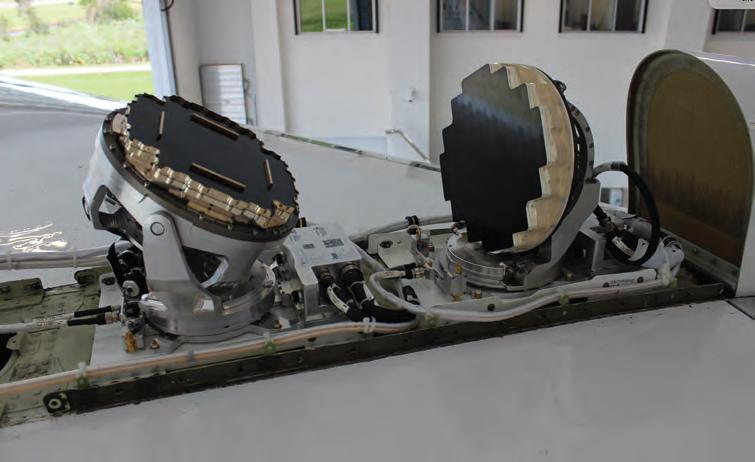
For OneWeb, Satcom Direct is working with antenna manufacturer QEST on an ESA (flat-panel) antenna, which will be installable on smaller aircraft. Demonstration transmissions have been tested with the new antenna, and Satcom Direct expects over-the-air tests in mid-2023 and availability about a year after Plane Simple Ka hits the market.
While the ESA antenna opens the market for smaller aircraft to Satcom Direct, Christensen sees this as supplementing the current satcom market.
“We see combinations between different technology and satellite constellations,” he said. “ESA will enable us to get into smaller airframes, and also provide a great alternative with a global footprint. This will open up markets that till today haven’t been served.”
Further, the discussion about which network is best, GEO, LEO, or even mid-earth orbit, “is irrelevant,” he said. “LEOs are not going to make GEOs extinct and vice versa. We need to talk about what the user experience is. In the end, the customer sitting in the back, they don’t care [which network is used].
“There are many entries to this realm,” he concluded. “If you look at all the efforts going on in the space segment, both with legacy and new entries—OneWeb, Starlink, Kuiper—it’s exciting [to see] that highe r level of interest providing more options for customers. We take every entry seriously and see [each one’s] benefits and drawbacks.”
Cobham has been manufacturing Inmarsat SBB hardware and providing SBB service for more than 20 years and now has mor e than 4,000 aviation systems in the field. STCs are available for Cobham SBB installations on a variety of business aircraft from Bombardier, Cessna, Dassault, Embraer, and Gulfstream.
The Aviator S series by Cobham is available in four different sizes, depending on the system speed and thus size of the antenna. All of the Cobham Aviator S SBB satcoms are safety-service qualified and also support voice communications.
Aviator 200S fits on almost any size aircraft and weighs about 22 pounds. It is capable of 200 kbps service. Aviator 300S boasts speed of 332 kbps with a system that weighs about 22 pounds. Moving into the high-gain-antenna arena, Aviator 350S offers 432-kbps service, also at 22 pounds. And Aviator 700S can handle four 432kbps channels with a system that weighs 46 pounds.
Up next for Cobham is development of a new airborne terminal for Inmarsat’s SwiftJet service, and this is coming in about two years.
Orbit offers an alternative to the traditional satcom airborne terminal providers, with its GX30 Inmarsat Ka-band system. Last August, Orbit announced that the GX30 was approved for use on Inmarsat’s Global Xpress network.
The AirTRx 30Ka for business aviation is a two-LRU system with a 12-inch ant enna that can be fitted to super-midsize and larger jets. System weight on t he tail is 22 pounds and speed is up to 130 Mbps, depending on the terminal and network.
Orbit’s GX30 is designed to work on a variety of satcom networks, including LEO through GEO constellations.
Iridium was first out of the gate with its L-band LEO satellite constellation, which has been in operation for more than two decades. The first satellites have been replaced by the Next series, which deliver more speed and capacity for Iridium’s Certus products. Top speeds are 700 kbps, which is sufficient for data offloading (telematics), flight tracking, messaging, and voice calls, but not heavy-duty applications such as video streaming.
Iridium Next satellites also carry ADS-B receivers for Aireon, which uses them to provide surveillance of aircraft over oceans and sparsely populated areas where there is no radar or ADS-B ground stations.
The 66 Iridium satellites (and 10 spares) communicate with each other on Ka-band frequencies. This helps Iridium keeps costs down because it doesn’t have to build ground stations all over the world to move data around, according to executive director of aviation John Peterson. “I can have an aircraft halfway over the Pacific, and it talks to a satellite, then that message gets bounced to a satellite [elsewhere] then drops the data to a teleport.” With so many satellites operating in six orbital planes, Iridium coverage is worldwide.
Not only do Iridium’s L-band signals to and from ground and airborne terminals penetrate moisture, but the ability to communicate between satellites means that even if signals were blocked from satellite to aircraft, they can still be rerouted to another satellite that is able to reach the teleport or terminal.
L-band can’t handle high data rates, Peterson explained. “We prefer to stay in the safety [service] side and can provide that level of service to the cockpit. Kaand Ku-band [systems] can handle the cabin side.”
Certus operates at four speeds: 22, 88, 350, and 700 kbps. The higher the speed, the higher the cost of the service and the Iridium modules that are the heart of airborne and other terminals. Iridium manufactures the modules and sells them to VARs/VAMs that can build their own terminals (sometimes called modems) or buy complete terminals from Iridium.
The first Certus products released about two years ago were the 22 and 88 kbps modules, but now the 350 and 700 modules are available and resellers are incorporating them into new products, for example, Collins Aerospace, Honeywell, and Skytrac.
Iridium’s higherspeed Next satellite constellation offers service speeds of up to 700 kbps, and connectivity is available anywhere in the world, including polar regions.

For service provision, Iridium customers work with VARs such as the above manufacturers and companies like Satcom Direct. Safety service requires at least the 350 kbps system.
Two antennas are available for Iridium Certus, a low-gain antenna that is a 3.5-inch-diameter disk and an active highgain antenna measuring 15 inches long, 8 inches wide, and 2.5 inches tall. The highgain antenna can still fit on a wide variety of aircraft.
Certus service is billed at dollar-per-megabyte rates, “more like a cellphone plan,” according to Peterson. To help cust omers keep costs down, Iridium Messaging Transport (IMT) was r eleased in the past year. This provides bi-directional messaging but where data is collected and then sent all at once and stored in the Amazon Web Services cloud until it is needed. “Now an app provider can suck it in, process it, and produce a result,” he said. A use case for IMT could include apps like Daher’s MyTBM, which uses engine and airframe data to analyze and track performance. “The biggest issue in analytics is that the cost t o get data has got to be less than the value the data brings,” he explained. Other L-band
satellite systems are more expensive and VHF datalinks aren’t always available. “We’re bringing a solution to aviation that it’s been looking for a long time, a reliable pipe to get data off or on the aircraft.” IMT is available with any level of Iridium Certus service.
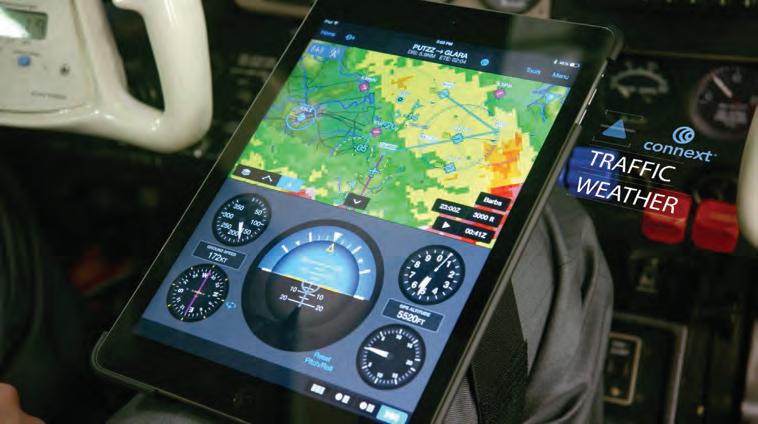
With two more launches scheduled in the second quarter, OneWeb’s LEO constellation will reach its full strength of 588 satellites. A January launch brought the total to 542. OneWeb’s global LEO aviation service will be available initially through Gogo Business Aviation, either as a standalone satcom or paired with other systems such as Gogo’s Avance L3 or L5 ATG solution or other LEO or GEO satcoms. Satcom Direct is also developing OneWeb airborne hardware and will serve that market.
OneWeb is also not an L-band system and operates on Ku-band from the satellite to the terminal and Ka-band for communications to the satellites. OneWeb has the
capacity and speed to allow video streaming, according to Jason Sperry, head of business aviation.
OneWeb is targeting small to large aircraft, any that can accommodate Gogo’s ES A, which was developed by Hughes. Hughes also developed the ground gateways and airborne terminals for OneWeb and Gogo.
The product launch timeline for OneWeb’s aviation service is likely around early 2025. With the Gogo ESA, Gogo’s modeling shows that users will see peak speeds of up to 57 Mbps to the aircraft and 3 Mbps from the aircraft to the satellite.
Part 135 airline JSX is the first operator to implement Starlink, which has been installed on its Embraer ERJ-145s. The STC was done by Aerospace Design & Compliance, a Wilmington, Delaware engineering company.
According to information released by SpaceX last year, STCs are underway
As the only LEO network operating until Starlink, OneWeb, and others come along, Iridium had a big head-start on LEO satcom. A variety of companies have developed Iridium communications devices, from low-cost personal tracking and SOS messaging units from Garmin, Skytrac, and others to portable and installable messaging-only products for aircraft from Airtext and Bizjet Mobile. Iridium recently unveiled its Go! exec portable satellite communicator with Certus 100 capability (88 kbps download, 22 kbps upload).
In addition to the inReach personal Iridium devices, Garmin manufactures the
for Bombardier Globals and Challenger 300/350s; Embraer ERJ-135s and Legacy 600/650s; Dassault Falcon 2000s; and Gulfstream G450s, G550s, and G650s.
A Starlink installation includes an aero terminal box, power supply, two wireless access points, harnesses, and an ESA that mounts on the top of the fuselage. The antenna will require a fairly large airframe to accommodate installation, so thus far, it appears that Starlink won’t be an option for smaller aircraft.
Aircraft hardware will cost $150,000 and service plans range from $12,500 to $25,000 per month. A reservation for a future delivery slot requires a $5,000 payment.
SpaceX claims network speeds up to 350 Mbps to each airborne terminal. There will be no long-term service contracts, according to SpaceX, and “all plans include unlimited data.”
AIN has repeatedly tried to contact SpaceX for further information and has received no response.
GSR 56 Iridium voice and messaging system for permanent installation in aircraft. At $10,495, the GSR 56 offers voice calling and messaging either through the aircraft’s installed Garmin avionics or using the Garmin Pilot app (Android or iOS versions). The app functionality requires that the aircraft also be equipped with Garmin’s Flightstream 510 wireless gateway.
Other services available via the GSR 56 include worldwide weather with highresolution weather radar in some regions. Operators can also track the GPS position of GSR 56-equipped aircraft anywhere in the world.
While it is likely that Garmin is working on a Certus version of the GSR 56, the company doesn’t discuss future products and waits until they are certified and/or ready for delivery before unveiling them.
Skytrac continues to support customers with legacy equipment—more than 8,000 in 100-plus countries—while it is focusing on bringing Iridium Certus equipment to market. So far, the company has introduced a mid-band and broadband Certus system.
“Currently Iridium is and has been a proven network that is truly global, interlinked, and provides us with the [system] size, weight, and power that is not paralleled by other providers,” said Jan Van der Heul, Skytrac v-p of sales.
For its mid-band products, helicopters are an important segment. “Starlink antennas are too big to put on helicopters,” he explained. “For that market, Iridium Certus is the sweet spot. Our antennas fit on tailcones, canopies, and fin tips. We’ll find a spot for it.”
For larger aircraft and “operations that require broadband in remote locations, we have the size, weight, and power requirements to fit on those aircraft.”
Mission-critical operators rely on Skytrac, he explained, not just for communications but also flight following and position
reporting. “In search and rescue and ISR, you have communications that are not interrupted and risking the operation.”
Skytrac’s mid-band Certus system is available with 88 kbps to the aircraft and 22 kbps to the satellite, while the broadband system offers broadband 704 kbps to the aircraft.

While Skytrac is offering upgrade incentives, it is also seeing new customers for its Certus products, especially those who want the highest speed for offloading video content, according to Van der Heul.
Buyers of the broadband Certus equipment get another advantage besides speed, and that is the ability to provide dedicated and separate service to the cabin and cockpit . The flight crew could use the system for safety services, for example, while passengers use their capacity for messaging, voice calls, and more dataintensive functions.
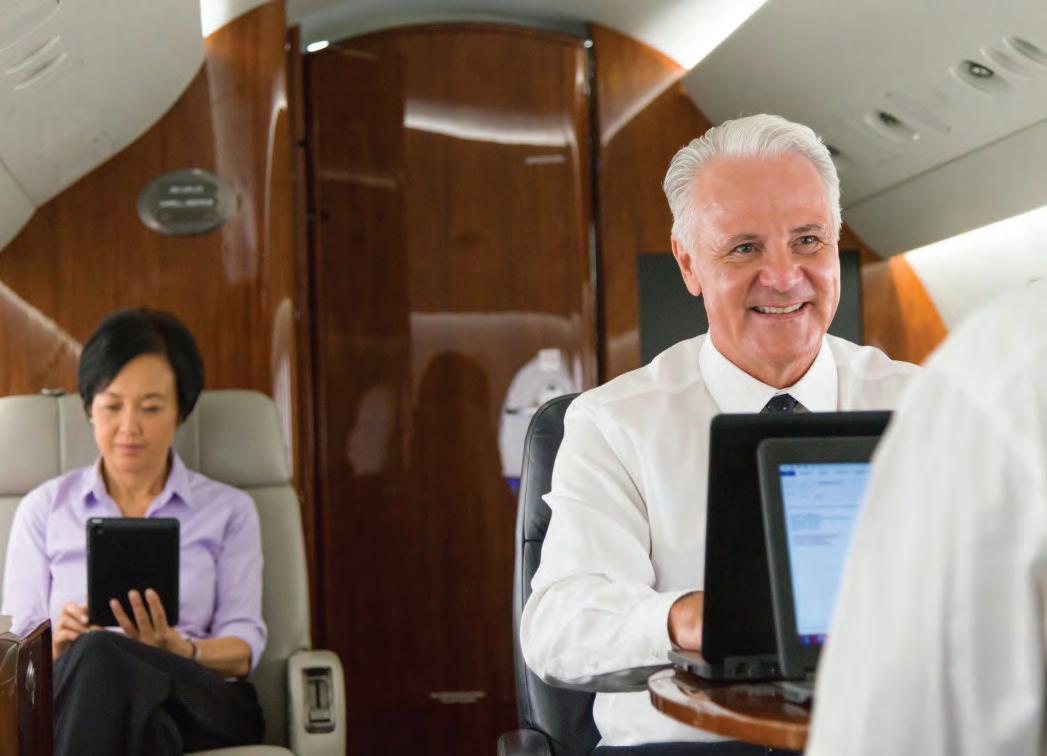
Honeywell’s Aspire
Iridium satcom offers a lower-cost alternative for airborne connectivity and can also include FANS datalink capability.
STCs are available for Skytrac installations in a variety of helicopter and fixedwing types. Flight-tracking customers can also take advantage of Iridium’s Aireon space-based ADS-B service and integrate that into the data stream in Skytrac mapping products.
Honeywell is a value-added manufacturer of the Aspire 150 and 350 Iridium terminals. Lighter than previous-generation I ridium equipment, Aspire’s high-gain antennas can be installed on a variety of aircraft. Aspire 150 provides operators with fast and reliable connectivity at lower costs, according to Honeywell, while the 350 provides these same features but adds FANS datalink capability. Both provide segregated Iridium cockpit safety services and Certus high-speed voice and data connectivity at speeds up to 700 kbps.
Collins Aerospace was an early developer of Iridium systems, with more than 3,000 fielded.
Its new Certus satcom—the IRT NX—offers all the Certus features such as safety services, segregated cockpit and cabin communications,
For aircraft already equipped with a Gogo Avance ATG system, adding OneWeb involves mounting the antenna and connecting it t o the Avance system and to power, then upgrading the Avance software.
Gogo’s Hughes ESA measures 24 by 11 by 2 inches and mounts on top of the fuselage.
Gogo’s airborne equipment should complete DO 160 environmental testing and be ready for submittal to the FAA for supplemental type certificate (STC) development and parts manufacturer approval in late 2024, according to Jim MacDougall, v-p of product management.
“We expect that we’ll have a prototype flying earlier than that. We plan to have a lot of STCs at market launch,” although Gogo hasn’t identified which aircraft will be first.
Gogo hasn’t revealed costs of the OneWeb equipment or service yet. “That wil l be coming in the next couple of months,” MacDougall said. “We want to be extremely competitive and disruptive on hardware pricing.”
As for service pricing, MacDougall explained that various plans are envisioned, from a single price for a certain number of gigabytes of data per month covering both ATG and satcom or a low-cost introductory
Gogo Business Aviation pioneered ATG connectivity in the U.S. starting in 1997 and now has more than 6,600 aircraft equipped, 2,900 of those with its Avance L3 and L5 systems. Avance, introduced in 2017, delivers faster speeds, around the same as ground-based 4G LTE cellphone networks and allowing users to stream video and send and receive large attachments.
Demand for connectivity is at an alltime high, according to Gogo president Sergio Aguirre. Users are doing data-heavy activities such as using Zoom, FaceTime, and Microsoft Office 365. In the fourth quarter of 2022, Gogo saw a 38 percent increase across all systems in megabytes
consumed per flight. The company also saw a 29 percent increase in daily flights compared with the same period in 2019.
Aircraft equipped with Avance L5 will be able to upgrade fairly easily to Gogo’s new 5G ATG service, which will deliver about 25 Mbps on average with peak speeds between 75 and 80 Mbps. Gogo said it remains on track to launch its 5G service in the second half of this year, now that it has successfully completed critical design review of the 5G chip needed for the new system. The ground network was completed for the U.S. late last year and expansion to Canada is ongoing this year.
Gogo has been working with manufacturers and authorized dealers on STCs that will cover more than 30 aircraft models.
FANS datalink, voice calling, worldwide weather, low- or standard-resolution video, and more, all at speeds up to 700 kbps.
plan, perhaps hourly, for aircraft that don’t fly as much. “We’re trying to provide a lot of flexibility to meet customers’ needs and not tell them this is what you get,” he said.
Satcom Direct is joining the LEO market with a OneWeb terminal and antenna and expects to have systems available not long after OneWeb’s constellation is complete later this year.
SpaceX is the manufacturer of Starlink equipment. For more details, see previous discussion of the Starlink network.
Customers can install Gogo’s Avance L5 platform now with 5G provisions and operate on the company’s 4G network until the X3 LRU is available.
Gogo’s service currently covers the continental U.S., part of Alaska, a good amount of Canada, and a portion of northern Mexico and the Gulf of Mexico.
Avance L5 retails for $141,132. With 5G, the Avance L5 systems costs $221,736. An upgrade from a current L5 to add 5G will cost $110,244. All of these prices don’t include installation. Airtime prices for Avance L5 range from $4,345 unlimited to $9,995 (unlimited plus streaming) per month. The 5G data plan prices will be $5,000 (10 GB) to “$6,200 (20 GB) per month.
“We’re off to the races,” said SmartSky CEO David Helfgott. “[SmartSky] is available today, we’re selling it and flying aircraft on our network.”
So far, the new competitor in the U.S. ATG market has fielded 12 STCs covering Cessna Citation XLs and Xs, Gulfstream IVs through G550s, Bombardier Challenger 601s through 650s, Embr aer EMB-135s and -145s, Dassault’s Falcon 900 series, and King Airs. And more are coming, according to SmartSky president Ryan Stone.
SmartSky is working with dealers and aircraft OEMs on new STCs. “With Textron Aviation, we’re pushing very hard,” Stone said, “and there are a lot of models we’re doing.”
“There is very strong interest in the small jet and turboprop market,” Helfgott added.
Customers are using SmartSky for video streaming and other data-intensive applications, according to Stone, including
mor e uploading from the aircraft, which traditionally hasn’t been very fast. “We have more bi-directional connectivity,” Stone said. “One customer said the SwiftBroadband bill went down dramatically,” he added, explaining that this was whe n that customer was flying inside SmartSky’s
time], and we have 30,000 beams that are high capacity and independent. We’ve engineered the geometry of the network around heavy flight routes. With that many beams and the nature of business travel, we’re well prepared for growth.”
The airborne SmartSky equipment is priced at $119,999, and installation takes seven to 10 days, depending on the aircraft and what other work is being done at the same time. The equipment includes the aircraft base radio and two antennas that mount on the aircraft’s belly.

coverage area over the U.S. While the network provides service in the areas where m ost business aircraft fly in the U.S., SmartSky is still deploying some antennas in the north-central and western U.S.
“We are engineering for peak capacity,” said Stone. “There are 1,000 to 1,100 b usiness aircraft in the air [at any given
Airtime rates range from $3,495 per month for 5 GB of data to an unlimited plan for $9,995 per month. For all plans except unlimited, overage fees are $1,495 per GB.
SmartSky also offers digital products to enhance its services, such as Skytelligence aircraft and flight data and SmoothSky real-time turbulence reporting.
Next up for SmartSky is a version of its system designed to fit smaller aircraft, with just a single antenna. z

After some two decades of talk and unmet requests, the demand for voice control on business aircraft is finally being answered. Several factors underpin the advance: voice control has become part of the fabric of everyday life, thanks to Alexa and Siri; evolving technology can now promise seamless simplicity for integrating voice control into cockpit and cabin systems; speech recognition and command are seen as essential for enabling aviation’s Advanced Air Mobility (AAM) future; and perhaps most importantly, research has shown that voice command can reduce workload and increase safety for flight crews.
Here’s what companies leading the onboard voice command revolution are doing now and have planned.
Garmin International was the first company to bring certified voice command
capability to the cockpit. It was featured in a 2016 software upgrade for Garmin’s GTN 650/750 touchscreen navigator series displays paired with its GMA 350/GMA 35 audio panels. The Telligence voice command system, engaged via a yoke-mounted push-to-command button, uses automatic speech-recognition technology that understands “intuitive phraseology,” the Olathe, Kansas company said, and it accepts hundreds of common task commands.
Crew members can tune radios, get flight information, navigate through the flight deck’s menus, and more using their voices. The command “Tune…,” for example, can call up frequencies for ATIS, airport towers, approach facilities, air traffic control centers, and other frequencies drawn from the flight plan in the systems. The command, “Say…” induces the system to provide the requested information in speech via the
audio panel. Crews can call for charts to be displayed, then zoom in and out on the display by voice command, as well.
Telligence is also available for helicopters via the GMA 350H audio panel, an ideal application for the technology, as both of a rotorcraft pilot’s hands are often occupied operating control inputs. Switching comms is as simple as saying “MIC 1” or “MIC 2.”

As with all voice command systems to various degrees, crew members must train with Telligence, performing at least 85 percent of voice commands as part of the qualification procedure, and they must be proficient in English and follow proper enunciation, speech cadence, tone, and volume guidelines for voice command to work properly.
As for current voice command R&D efforts, a spokeswoman for Garmin told AIN that it is “always innovating and
working to provide enhancements” to its voice command technology to add “industry-leading features.”
The forthcoming Anthem flight deck from Honeywell Aerospace—the fifth generation of the company’s Primus platform—promises to introduce an advanced voice-recognition and command-capable certified flight deck.

“The goal is to allow more natural interaction such that pilot mistakes are less l ikely,” said Jason Bialek, Honeywell’s director of product marketing. “Assuming you’ve implemented it correctly and overcome accuracy and latency problems, it should pr ovide an experience like you’re flying with another pilot, versus having to force yourself to think about how you’re inputting things.”
Anthem is distinguished by its easily customized, firmware-controlled core, which receives all inputs and drives all displays and is scalable to aircraft platforms of any size. The system architecture allows much quicker development of applications and much greater control over the look and feel of the presentation and the experience, lending itself to OEM customization and branding in their aircraft without disrupting Anthem’s key objective of making flight safer and less complex for pilots.
Anthem’s voice-command applications will allow pilots to speak conversationally to the system and support a wide range of commands and piloting duties. Moreover, the data and processing behind the technology are all housed within Anthem, so it requires no connectivity.
As onboard data-processing power and storage capacity increases, “You’ll be able to bring the much broader, richer experience that we know as consumers to the cockpit, and you’ll be able to say and have it understand more and more things,” Bialek said.
Additionally, Anthem can support thirdparty applications through cloud connectivity, and Honeywell anticipates that flight

crews will access EFB-type apps while airborne that may also incorporate voice command capabilities.
Demand for Anthem is high, “and for this speech capability in particular,” said Bialek, though speech will be only one of
a pilot’s input options, which will include forward touch (i.e., pilots can make touchscreen inputs directly on displays, rather than through an intermediate controlling device on the panel) and traditional key displays, whether physical or screen-based.
At least two unnamed OEMs have signed up to bring Anthem to their panels, which the company last year expected to introduce in 2023, but the manufacturers have pushed back their introduction dates. Honeywell itself has also proceeded carefully with perfecting the application to ensure that it’s ready when launched.
“We want about a 90 percent or better [correct command communication] level, even in very noisy environments, and right now we’re getting about 90 percent or better,” Bialek said.
But given the delays in bringing Anthem to market, the Phoenix company will debut its first voice command in the fix ed-wing business aircraft cockpit via an upgraded version of its current, fourth-ge neration Epic flight deck, with at least one customer already contracted. Voice command on the Epic platform— which anchors the cockpits of in-production business jets under the Cessna C itation, Dassault Falcon, Embraer, Gulfstream, and Pilatus brands—will be more rudime ntary but will allow pilots “to do things like tune a radio frequency, show a chart, zoom in and out on your map, and set overlays on the map with very specific commands,” Bialek said.
Meanwhile, since Honeywell established its Urban Air Mobility and Unmanned Aerial Systems business unit in 2021, three eVTOL manufacturers—Lilium, Vertical Aerospace, and Supernal—have announced the selection of Anthem flight decks for their platforms, a positive sign for its application in the upcoming AAM environment.
“We can bring Anthem into almost anything that’s currently flying or will fly in the future,” Honeywell has said about its AAM prospects.
The Lilium Jet is a piloted, seven-seat aircraft that will take off and land vertically, cruise at about 152 knots, and have a 135-nm range. Vertical’s VA-X4 is a piloted, five-seat, battery-powered aircraft that also lifts vertically and has a top forward speed of about 174 knots.
This past October at NBAA-BACE, Supernal, the advanced air mobility division of Korean car maker Hyundai, selected Anthem to drive its cockpit. Supernal plans to integrate an array of complex technology that it will be using for the SA-1 eVTOL vehicle, with a commercial service launch target of 2028. Anthem will support plans for ensuring a high degree of autonomy in its operations. Supernal said it expects to start the FAA’s type certification process for the SA-1 in 2024.

SA-1 will initially be piloted and carry four passengers, but an autonomous, six-passenger variant is planned. It is being designed to cruise at up to about 157 knots at 1,000 to 2,000 feet agl, with a range of some 52 nm on a single charge.
Honeywell also manufactures the Ovation Select cabin management system (CMS), introduced in 2011, which has been installed on Boeing, Bombardier, Dassault Falcon, Embraer, and Gulfstream jets. Asked whether voice control would be added to Ovation’s features, Honeywell said it expects “OEMs will incorporate common-sense speech controls for controlling cabin lighting, sound systems, and other things similar to what many of us already do in our homes with Alexa, in their own cabin systems,” but the company hasn’t said it will add voice to Ovation.
The potential benefits of voice command in the cockpit have drawn interest that extends beyond avionics manufacturers and their eager customers. The recent Voice Crew Interaction (VOICI) project conducted under Europe’s Clean Sky 2 program—the largest aviation research project in the Continent’s history—investigated creating an intelligent, voice-controlled “natural crew assistant” for the cockpit as part of the pr ogram’s objective of identifying cutting-edge technologies to reduce CO 2 , g as emissions, and noise levels produced by next-generation aircraft.
VOICI created an Audio Evaluation Environment, or cockpit demonstrator, enabling evaluation of the system at Technology Readiness Level (TRL) 3—experimental proof of concept—by end-user pilots.
The demonstrator emulated a Dassault Falcon 2000 cockpit in flight and included calibrated cockpit noise recorded onboard a Falcon 2000, with the audio split into multiple channels representing multiple noise sources. The system incorpor ated and tested technologies including speech capture; speech recognition and interpretation/dialog; and speech synthesis for dialog with the crew.




The demonstrator’s processing engine used a context-dependent language model and deep-learning approaches for training, after which it exhibited a 5 percent word-error rate in cruise flight conditions. Speech-based feedback to the pilot was provided by a text-to-speech function optimized for a noisy environment.
Two speech-capture methods were tested on the cockpit assistant (nicknamed “Solo”): a standard pilot’s headset microphone, and an ambient microphone array in the cockpit. The input was processed by stand-alone speech/dialog processing functions within the self-contained system, obviating the need (and risks) of cloud connectivity. The functions included voice-activity detection, speech enhancement, context-dependent speech recognition, and text-to-speech for the noisy environment.
The research found that a headset’s close-talk microphone is superior to an array of embedded microphones in a cockpit environment, but also revealed that arrays of very-low-noise optical microphones produced significant noise suppression when used with modern beamforming algorithms; researchers declared that the beamforming technology represents “a significant project exploitation potential both in aviation/transport and in a much wider market.”
The two-year VOICI project ended in 2020 but determined that voice command supported Clean Air 2’s objectives b y reducing crew workload and stress; enhancing safety and efficiency; reducing the cost of operations; and improving maintenance.
Moreover, a system architecture demonstrator enabled researchers to validate the complete cockpit solution concept— including detailed flight crew interfaces, functions, and performance—to TRL5, denoting laboratory testing of an integrated or semi-integrated system, on a virtual system integration bench.
But going forward, an aircraft cockpit, with its ze rofault environment, will likely not be leading the advances in onboard voice command application; The potential conseque nces of miscom - munication or misunderstanding are too great. The cabin will likely host the more ambitious voice command applications, an evolution already underway.

The latest iteration of Lufthansa Technik’s Nice (network integrated cabin equipment) CMS, featured as standard equipment on Bombardier’s Global 7500 and Challenger 3500, includes advanced artificial intelligence-driven voice command for cabin systems.
The multilingual system “uses an intelligent algorithm that learns commands with time, so it gr ows and evolves,” said Wassef Ayadi, senior director of customer relations and sales support services at Lufthansa Technik (LHT). “It can be
trained to understand certain behavior, and to react accordingly. Commands are given via small control units throughout the cabin and can be engaged by speech or clicking on the voice-control command.”
Nice’s enhanced capability reflects LHT’s and the industry’s goal of delivering the home- and office-like experiences that consumers have come to expect into the sky. But unlike Siri, Alexa, and most other popular voice-recognition systems, Nice voice command requires no internet connectivity—all the software is contained in the CMS.

“Not every aircraft is connected [to the internet] from a cabin connectivity standpoint,” Ayadi said, explaining one reason for having a self-contained system. Additionally, “We know privacy for this target group is very important,” a concern obviated when commands and possibly other onboard dialog never go to the cloud.
LHT continues developing the system’s capabilities, but its vocabulary and commands can expand as it learns, “as a human being does when you interact and the machine is really fed a lot of information,” Ayadi said. “You even forget that you are interacting with the machine.”
But as with a human, education counts: “The machine can differentiate emotions, nuances, and more, but if you feed it only a definite number of commands, the interaction the system can handle will be limited to those commands.”
Want to go faster, farther, and safer more sustainably?

The 2023 European Business Aviation Convention & Exhibition (EBACE2023), Europe’s premier on-demand aircraft and advanced air mobility event is taking off at the magnificent Palexpo in Geneva, Switzerland, and the Geneva International Airport from Tuesday, 23 May through Thursday, 25 May 2023.


EBACE2023 is the place where you will experience, enhance and help shape the future of business aviation. You won’t want to miss it — make plans to attend!


ebace.aero/2023
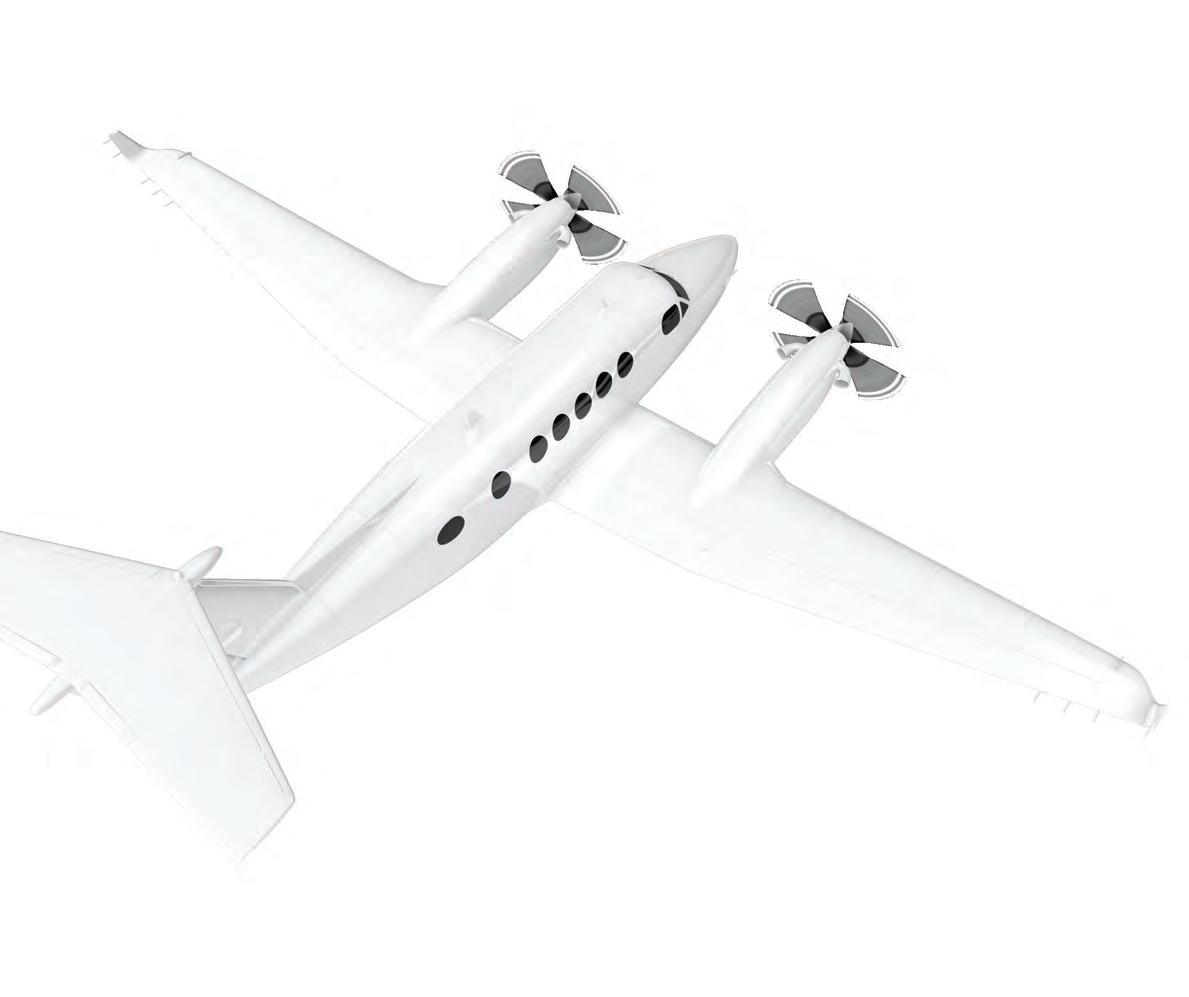
But why would passengers bother interacting with a system they have to teach?
“The key is to make technology hasslefr ee and as enjoyable as possible,” Ayadi said, adding that LHT is getting “very positive feedback” from crews, operators, and OEMs, and that the acceptance level from passengers has been high. He added that “some generational effect is playing a role in the way they interact,” suggesting younger passengers in general are more comfortable than older ones with using voice command onboard.
Additionally, Nice can be custom configured by operators to match the preferences of different clients, adjusting not only the voice-command system, but the entire onboard ambiance to create a personalized experience for each. In the future, LHT envisions that the system will handle much more than onboard chores, and be capable of accomplishing tasks— making reservations, arranging services, monitoring ground-based activities, and more—that human personal assistants typically manage.
Collins Aerospace also appears on the cusp of offering voice command in the cabin, but not in the cockpit. When the Charlotte, North Carolina company was established via a merger in 2019, the head of avionics marketing proclaimed that next-generation avionics by voice command “is one of the new features that will be commercialized in the short term,” but no development news has followed. Collins declined to share any plans for bringing voice command to its Pro Line series flight decks, w hich are installed in the panels of business aircraft including Bombardier Challengers, Cessna Citations, Gulfstreams, Ha wkers, Learjets. and Piaggios, or via other avionics platforms.
But Collins has announced plans to add voice control to its Venue CMS in the third or fourth quarter of this year. The system will use cloud access and artificial
intelligence to “deliver [a] superior user experience,” accessible and controllable via passengers’ own devices, the company said. The initial implementation will be on Apple iOS with Google Android to follow, and a development lab demo of the system is available for prospective customers.
However, voice command may not be the last word in onboard communication media—nor is it limited to the cockpit and passenger seating area. Diehl Aerospace, in collaboration with Airbus, showcased at the 2019 Aircraft Interiors Expo (AIX) an in-development voice-controlled Touchless Lavatory for commercial aircraft cabins.
“Highly developed sensors and finely responsive actuators offer hands-free procedures in functions like operating the
waste flap, water faucet, hands-free door handles, toilet seat, and lid and drying your hands,” the German company said, and “operation is self-explanatory.”
A special conversion kit would enable quick installation in almost all lavatories on an Airbus aircraft and require no major changes to the existing construction.

The timing of the product peek, just before the pandemic heightened hygieneconcern, was fortuitous. But Covid also darkened AIX and other in-person trade events for two years, and the beleaguered commercial aviation sector wasn’t spending on aircraft upgrades and retrofits.
Since that first showing, Diehl has determined that gesture control—using physical motion—offers more promise for a touchless lavatory environment, the company told AIN, and it has developed the technology for application in civil aircraft. z


AIN’s Paris Air Show News offers a full slate of impactful print and digital marketing opportunities:

› Show dailies packed with the latest news and announcements distributed on site and at major hotels June 19, 20, 21, and 22
› Digital editions for all four days also sent to the full AIN subscriber list
› Paris Air Show landing page on AINonline.com running from June 13 to July 12 featuring display and native advertising opportunities
› Four separately produced Paris Air Show Alerts newsletters with display and native advertising available

› Dedicated emails to a custombuilt audience of your design
› Boost your Air Show videos through AIN’s YouTube channel
› Interstitials running on AINonline.com
Close Date for Print: May 30th
Close Date for Digital: June 1st
Contact Sales Advertising: sales@ainonline.com
Contact Editorial: ainedit@ainonline.com
Two large pilot-training providers are gearing up for the emerging advanced air mobility (AAM) market.
FlightSafety International (FSI) plans to “develop eVTOL-specific pilot and maintenance training programs utilizing our experience of o ver 70 years in the training business,” said Kelly Reich, FSI senior v-p strategic operations. “We will leverage our existing training philosophy and focus on the unique equipment and operational needs of these new aircraft.”

FSI has various team members working with multiple agencies on what regulatory changes need to occur, Reich continued, and are helping “to identify the appropriate training needs, which drives the overall training curriculum.”
Reich said discussions with select eVTOL developers are well underway
to help prepare for the futur e market.
“The shift towards expected high volumes of pilots and maintainers means a shift in delivery strategies,” he said.
One such change is moving toward a greater amount of asynchronous remote training, delivered through the company’s existing eLearning platform, as well as ne w developments in remote or homebased delivery methodologies, Reich said.
“There are also different training elements and areas of focus to be considered
in eVTOL aircraft—from microclimate events and ground effects to urban environment operations and single-pilot controls. These unique aspects are being developed into our programs.”
In addition to working with individual aircraft developers, including Lilium, the company participates in committees to create consensus standards such as the SAE G-35 commit tee and GAMA’s Powered Lift Working Group.
“Our long-standing relationships with organizations such as the FAA and EASA also provide timely insights into the developing regulations in this segment,” Reich said.
Beyond physically pilot- po wered lift, FSI is looking into autonomy and the challenges and opportunities it presents.
... The shift towards expected high volumes of pilots and maintainers means a shift in delivery strategies.
“While most OEMs are initially developing crewed aircraft, there is the understanding that future evolutions will likely be uncrewed,” he said. “There are a number of options for what this may look like, be it ‘pilot in the loop,’ a pilot managing multiple aircraft, or even full autonomy with the aircraft operating with no human input. In the first two examples, we would see another significant shift in the skills required for these pilots.”
Reich said FSI’s technology and long history of rotorcraft training hold it in good stead moving forward.
“While our current fullflight Level D [simulators] meet the requirements for eVTOL training, we are actively exploring new technologies to enhance accessibility to equipment and reduce operational costs. We believe our mixed-reality ‘MRX’ devices will provide an excellent combination of realism and practicality to this emerging market. Combining traditional simulator technologies with VR [virtual reality] gear allo ws the visual ‘pass-through’ of real-world equipment with an immersive visual environment.”
He noted FlightSafety currently has both VR and mixed-reality training in military and civilian applications and said this technology will be useful in the eVTOL space.
FSI has pilot, maintenance, specialty, and enrichment courses covering helicopter models that run the size gamut from the single-engine Bell 407 to the heavy twin Sikorsky S-92.
“Our training platforms allow us to tailor the content to meet the needs of our cust omers’ missions,” said Reich. “We also produce specialty courses focusing on the unique environment and conditions helicopters operate in, such as night vision goggle tr aining, inadvertent entry into IMC, advanced helicopter energy management, and helicopter crew resource management.”
AAM is also on the radar at training provider CAE, whose Civil Aviation group president, Nick Leontidis, said his company is working with AAM aircraft developers including Vertical Aerospace, Jaunt, Volocopter, Beta Technologies, and Joby

Last year, CAE predicted AAM would drive demand for 60,000 to 70,000 pilots over its first decade of operations. The company noted that most of this would come from its existing airline customers, which account for 75 percent of the AAM industry’s order book to date.
make theses new devices cost-effective for a market with lower-priced aircraft.
The new device will use a wearable headset display combined with a compact minimotion platform and 360-degr ee field of view to provide high-fidelity, physics-based simulation with an immersive “out-thewindow” 3D environment.
The wearable mixed- r eality headset works with real cockpit controls and instrumentation to deliver realistic, low-flying scenarios, CAE said.
To begin to address this demand, CAE expects to certify and deploy its first AAM pilot training program by 2024.
To advance that goal, it is developing a high-fidelity mixed-reality flight trainer, the 700MXR, geared to the needs of single-pilot operations in a low-altitude, complex urban environment. This environment requires “a whole bunch of training requirements that we think will drive a need for a new training device,” Leontidis said, adding the goal is to
While each new AAM vehicle is unique, Simon Azar, CAE v-p of strategy, marketing, and adjacencies for civil aviation, said that many are using similar avionics and cockpits, enabling a baseline for the new training devices.
“What this industry is looking for is scale,” said Chris Courtney, CAE director of AAM. “There will also be a large demand for pilots to get initial training and current training. We believe that this new type of simulation device is a cost-effective solution for this new emerging market and the training requirements that are needed to operationalize advanced mobility.” z
What this industry is looking for is scale.
Aircraft checklists are the foundation of pilot standardization and flight deck safety. Following a series of air carrier accidents in the late 1980s, safety professionals began to recognize and have concerns that the improper use, non-use, or poor design of checklists could potentially contribute to an aircraft accident. Until this point, the design of the checklist and the philosophy of its use escaped input or analysis from human factors professionals.
The NTSB first recognized the importance of checklist use and its critical r ole in flight safety in 1969 following the no-flap takeoff crash of a Pan American Airways Boeing 707-321C from Elmendorf Air Force Base in Alaska. The crash of Pan
Am’s Clipper Racer—an all-cargo flight destined for South Vietnam—killed all three crewmembers.
NTSB discovered that “Flaps” appeared on Pan Am’s Before Taxi Checklist but was not included on the Before Takeoff Checklist. It was noted that the first officer lowered the flaps prior to taxi, but as the aircraft was preparing to be de-iced, the captain retracted the flaps. Afterward, the first officer remarked, “Okay, let’s not forget those.”
Among the probable causes of the crash, according to the Safety Board, were a defective checklist, the 707’s defective takeoff warning system, and stress caused by a rushed schedule. In its recommendation, the NTSB called for: “Air carrier
cockpit checklist t o be reviewed in an effort to ensure that each list provides a means of reminding the crew, immediately prior to takeoff, that all items critical for safe flight have been accomplished.”
Unfortunately, it took 18 years and three air carrier accidents during a 15-month period for the NTSB and industry to recognize the problems that relate to the human factors aspects of checklist design and procedures.
In the first accident, in May 1987, an Air New Orleans British Aerospace J-3101 (Jetstream) twin-turboprop crashed after takeoff in New Orleans. During the initial climb, the flight crew felt a severe yawing motion and engine torque fluctuations. The captain

attempted to land and overran the runway, crossing a highway striking several vehicles.
The NTSB concluded that “the engine rpm levers were either advanced to a position less than full forward or they were not advanced at all before takeoff, indicating a lack of checklist discipline on the part of the aircrew.”
A contributing factor, according to the report, stated that “The typeface of the Air New Orleans checklist was 57 percent smaller than the recommended human engineering criteria. This smaller typeface reduced the legibility of the print even under optimum conditions.” Furthermore, the NTSB would formally call for the FAA to issue an advisory circular to commercial operators recommending the use of a procedural checklist that incorporates human engineering design criteria for size and style of print.
The NTSB would also suggest that frequent change (change fatigue) in the checklist can have a negative effect on the checklist’s importance to the flight crew. Air New Orleans had recently introduced the Jetstream into its fleet, the report noted. “Frequent revisions of checklists for newly-acquired aircraft are understandable, but the fact that this normal checklist had been changed seven times between January and May 1987 [only five months] suggests to the Safety Board that its original design (the manufactur er) and approval (FAA) may have been inadequate and may have caused confusion among flight crews.”
In the second accident, only three months after the Air New Orleans crash, a Northwest McDonnell Douglas MD-82 crashed shortly after takeoff from Detroit Metro Airport following a no-flap/no-slat takeoff. The six crew members and 148 of the 149 passengers were killed in the crash. Two individuals were killed on the ground. The NTSB concluded that the probable cause of the accident was the flight crew’s failure to use the taxi checklist to ensure that the flaps and slats were extended for takeoff.
One year later, a Delta Air Lines Boeing 727-200 crew attempted a no-flap/no-slat takeoff and crashed 22 seconds after liftoff at Dallas Fort Worth International Airport. Of the 108 passengers and crew onboard the aircraft, 17 were killed and 76 were injured. The NTSB concluded that “the flight crew did not extend the airplane’s flaps or slats for takeoff.”
research group to determine “…if there is any type of method of presenting a checklist which produces better performance on part of user personnel.” Additionally, the Safety Board recommended that the FAA specify checklist typography criteria for commercial operators.
As a result, NASA began its journey to investigate the many human factors elements related to aircraft checklist design and procedures. Researchers found problems related not only to the physical design of the checklist but also to the social issues that led pilots to misuse it or not use it at all.
Human perception errors were likely in this accident considering the cockpit voice recorder captured the second officer reading the checklist, stating “flaps,” and the first office r responding, “fifteen, fifteen, green light”—a normal response. Presumably, the first officer would visually reference the inboard and outboard flap/slat position indicators (“fifteen, fifteen”) and the illumination of the leading-edge flaps and slats indicator (“green lights”). In this case, however, the position indicators would show “zero” and “no lights” without the flaps or slats extended. Active monitoring requires the pilot to “look for something” rather than “look at something.”
During the NTSB hearings into the Northwest Airlines MD-82 crash, the late Earl W iener—a human factors specialist and NASA scientist—testified at the time that he did not know of "any human factors research on how a checklist should be designed." Further research by NASA concluded that in 1989, there was essentially no human factors research available that pertained to aircraft checklists—anywhere, not in the U.S., Western Europe, or elsewhere.
Following the Air New Orleans Jetstream and Northwest Airlines MD-82 accide nts, the NTSB recommended that the FAA convene a human-performance
The output of this research included two research documents: NASA’s Human Factors of Flight-Deck Checklist: The Normal Checklist (Degani and Wiener, May 1990) and NASA’s On the Typography of Flight-Deck Documentation (Degani, December 1992). Afterward, the UK CAA produced a document (now in its third edition—2006), CAP 676: Guidance on the Design, Presentation, and Use of Emergency and Abnormal Checklist
NASA defines the major function of the checklist as to ensure that the crew will properly configure the aircraft for flight and maintain this level of quality throughout the flight and in every flight.
Generally, a checklist serves as a “job aid” for very complex operations: it aids in recall, verifies aircraft configuration (even when pilots are physically or psychologically “degraded”), provides a proper sequence of actions, provides a sequential framework for operational requirements, allows cross-checking, keeps all crewmembers “in the loop,” facilitates optimal crew coordination and workload, and is a quality management tool.
An overlooked objective in checklist design is its ability to promote a positive attitude towards the use of this document or procedure. For the front-line operator—pilots in this case—a checklist must be “well-gr ounded” in the current operational environment with a sound realization of its importance and not regarded
...the flight crew did not extend the airplane’s flaps or slats for takeoff.
Free food versus FREE FOOD
· Pilots like free food
· Aviation International News
· Human Factors
· Cable OutThousands forced to read
· She likes to play ball in the park
· PILOTS LIKE FREE FOOD
· AVIATION INTERNATIONAL NEWS
· HUMAN FACTORS
· CABLE OUTTHOUSANDS FORCED TO READ
· SHE LIKES TO PLAY BALL IN THE PARK
as a nuisance. By design, it should be an effective interface between the human and the machine.
There are two methods or philosophies in conducting or executing a checklist—the “challenge and response” or the “do-list.” Each method has its merits.
Challenge and response is more accurately termed “challenge-verification-response.”
Using these methods, pilots configure the aircraft for the appropriate flight phase using a “flow” pattern. A flow pattern is an ingrained sequence of actions performed from memory. After completion of the flow, pilots then use the checklist to verify that the critical items have been correctly configured; one pilot reads the “challenge” portion of the checklist—both verify—and the other pilot provides the appropriate response.
Generally, most modern aircraft utilize a “dark, quiet concept” (configuration redundancy) where if the aircraft is configured properly, the overhead panel (or systems panels) will not have any lights illuminated. In this case, all items in the flow pat tern may not be included in the checklist—a simple “overhead panel” challenge and a “set” response may be appropriate if each crewmember verifies that no lights are illuminated.
The challenge and response method is very efficient; each crewmember can accomplish their assigned flow patterns and then
Checklist steps...ALL CAPS
☑ THROTTLE.........................IDLE
☑ FUEL SHUTOFF LEVER............OFF
☑ ENGINE FIRE SWITCH........FULL FORWARD
Compare to preferred up and down/down style below.
☑ Throttle...............................Idle
☑ Fuel Shutoff Lever...............Off
☑ Engine Fire Switch...............Full forward
when everyone is “caught up,” the crew can collectively complete the checklist.
A “do-list” is more accurately termed a “call-do-response.” Using this method, the checklist is used to lead the pilots to a step-by-step (like a cookbook) procedure where one pilot directs the other pilot to configure a cockpit control. In theory, every flight deck control (switch, lever, or otherwise) would be listed on the checklist and both crewmembers would have to be present to accomplish the checklist.
The advantages of the do-list are that both crewmembers can verify the appropriate switch activation. Disadvantages of the do-list are that they are very detailed, and the checklists are time-consuming. As intended, each pilot must be in the seat for the entire process.
According to NASA, philosophies toward checklist design may vary based on the type of operation. A short-haul operator— greater than three segments per day—may choose to avoid a long meticulous checklist. Highly repetitive checklists may lead pilots t o develop “workarounds” that only include those critical items or skip the checklist altogether. For the long-haul operator—one to two flights per day— pilots may be less resistant to a more detailed checklist.


UK CAA’s CAP 676 incorporates a checklist audit tool (CHAT) to determine if a checklist complies with the best human factors practices as defined within the document. The CHAT is most effectively used as a gap analysis tool to identify areas where a checklist can be improved. Using this resource, an operator can grade a checklist in areas such as its physical characteristics, content, layout, and format.
Physical characteristics look at items such as the size of the actual document, contrast and color, and other details such as typography. One of the most common errors in checklist design is typography. There are two main factors that need to be considered, legibility of print and readability, to account for less-than-optimal reading conditions on the flight deck.
Legibility of print or discriminability involves the proper selection of alphanumeric characters to enable the reader to identify them quickly and positively from other letters or characters. Readability relates to the quality of the word or text to allow rapid recognition of a single word, word groups, abbreviations, or symbols. These factors, according to the research, are crucial for flight deck documents such as checklists.
Today there are thousands of typefaces or fonts available. Two major groups of fonts are applicable to flight deck documents: Roman and sans-serif. Roman is the style
of font typically used in newspapers. Sansserif includes contemporary fonts (Calibri or Arial, for example) that do not include the little strokes (serifs) that project horizontally from the top or bottom of a main stroke. Research has shown that sans-serif is more legible for lists, although not for big blocks of text. The absence of serifs presents a more simple and clean typeface. Arial or Helvetica are preferred.
DevelopersKeepEyesonSupersonic,HypersonicPrize TheAerionCorp.decisioninMay 2021toceaseoperations immediately raisedquestions onwhetheritwas a“category killer,”theendofsupersonicaspirations.Afternearly two decades ofdesignefforts,Aerionwas believedtohavetheinsidetracktoreturningacivil supersonicaircrafttomarket.However,alackofsupportfromtheinvestmentcommunity broughtthoseefforts toascreechinghalt,raisingquestions abouttheviability of supersonic.
descenders (“p” or “q”) that contribute to the unique pattern of a word. Lowercase words appear “characteristic” whereas upper case words appear like a “RECTANGULAR BOX.” The use of UPPERCASE words for checklist titles is allowable, but the up and down style is preferred ( See image on previous page).
and black text on a yellow background is acceptable (CAA).
Designing a checklist should be easy, right? Thirty years ago, researchers often encountered the following statement, “Checklists are simple and straightforward, so what is there to study about them?” For air carriers (121 operators in the U.S.) the design of a checklist that incorporates human factors considerations was not a priority until the early 2000s.
Theissues forAerionwerefinancialratherthanatechnologicalbarrieras the company hadaccruedsomefour-dozenpatents.Further,itwas justoneofseveralefforts underway,andatleastone,involvingapartnershipbetweenSkunkWorks giant LockheedMartinandNASA,may play akey roleinthefutureofsupersonicflight.
ReadMore
BJT:Data,ForecastsBearGoodTidingsforBizav

Buyers,sellers,andthosejustthinkingaboutgettingintoprivateaviation—there’s somethingforalltocelebratethis holiday seasonas data,forecasts,andanecdotal evidencebeargoodtidings forthepreownedmarketinthecomingyear—thethirdofthe Covidera.
Ifyou’reapreownedaircraftbuyer,expectprices tostabilizeorstarteasingandselection toincrease.Ifyou’reshoppingyouraircraft,youneedn’tworry thatthebottomis aboutto dropoutofwhatstillremains aseller’s market.Andifyou’renewtobusiness aviation, youcantakeyourtimemakingtherightaccess decisions,sans FOMO.
ReadMore
FromtheArchives:CirrusJetPilotReport
InJune2007,Cirrus Aircraftunveiledtheconfigurationofits newsingle-enginejet.Atthe time,itappearedas thoughCirrus was jumpingonthesamebandwagonas otherwouldbeorexistingaircraftmanufacturers.Theapparentmarketforasingle-enginejet,ifallthe prognostications weretobebelieved,was goingtosoar,partofthethen-currenthype projectinghugefleets ofvery lightjets abouttocloguptheworld’s airspace.
Many checklists are published using ALL UPPERCASE letters—this is usually an attempt to add emphasis. The consensus of researchers is that lowercase is preferred and recommended over uppercase. Lowercase is more legible because the pattern of a word is stored in the human memory (think of “sight words” that are taught to children). Lowercase words have ascenders (the vertical stroke of a “b” or “d’) and
Thelistofwould-besingle-enginejets was long,yetonly ahandfulhaveactually flown: theVisionAireVantage,PiperJet,Eclipse400,DiamondD-Jet,andStratos 714.While
Stratos’s efforthas recently seenrenewedactivity includingflighttesting,only one— Cirrus’s SF50VisionJet—has madeitintoproduction.
ReadMore
BoeingToFaceCriminalChargesRelatedtoMaxCrashes
ATexas federaljudgehas ruledthatBoeingmustappearincourtonJanuary 26for arraignmentonfederalcriminalcharges relatedtothetwincrashes of737Maxjets that claimedthelives of346people.Initially,theU.S.DepartmentofJustice(DOJ)granted Boeingimmunity fromcriminalprosecutionas partofa$2.5billionsettlementreachedin January 2021.However,thelawyers forthevictims’families arguedthattheyshouldhave beenallowedtoparticipateinthecaseundertheCrimeVictims’Rights Actandthejudge agreed,rulinginfavorofthevictims lastOctober.
Thecrashes in2018and2019in Indonesia and Ethiopia ledtoa20-monthgroundingof the737MaxandpromptedtheU.S.Congress topass legislationreformingairplane certification.
ReadMore
FutureFlight:AskaeVTOLSetfor2026ServiceLaunch NewFutureTransportation(NFT),thecompany behindthe Aska personaleVTOLaircraft billedas a“flyingSUV,”nowsays itplans tostartofferingon-demandairtaxiservices as early as 2026.However,recently announcedplans arebasedonarrangements thatwould appeartostretchthecurrentregulatory requirements forcommercialflights by building oncurrentpractices intheground-basedride-sharingsector.
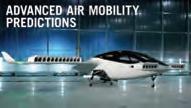
TheCalifornia-basedstartupunveiledthefour-seat,hybrid-electricAskaA5“drive-andfly” eVTOL inApril2021,whenitbegancollectingpre-orders fromprivatebuyers.With fourmotorizedwheels andfoldablewings,NFTsaidtheAskawillbeabletoquickly switchbetweendrivingandflyingmodes,andit’s compactenoughtoparkonadriveway orinagarage.
ReadMore
WaltDisney’sOtherMouse
WhileWaltDisney usedvarious commercialandbusiness aircrafttosupporthis many entertainment,entrepreneurial,andphilanthropicprojects,theonemostclosely associatedwiththemanandhis dreams was his belovedGrummanGulfstreamI.
Thinkaboutit:inoneway oranother,whetherthroughmovies,TV,oravisittothe
“HappiestPlaceOnEarth,”thetalentsofWalterElias (Walt)Disney havetouchedallof ourlives.
ReadMore
giant LockheedMartinandNASA,may play akey roleinthefutureofsupersonicflight.
NASA,BoeingToFlyTruss-braced-wingDemonstratorin2028

ReadMore
NASAandBoeingwillcollaborateonbuildingandtest-flyingasingle-aislecommercial aircraftdemonstratorusingatruss-braced,high-aspect-ratiowingscheduledforfirst
The type size is important for readability, especially for older pilots. At about age 50, there is a 50 percent reduction in retinal illumination as compared to a 20-year-old. In general, a font size between 14 and 20 is recommended. CAP 676 and FAA 8900.1 recommend headings to be printed at type size 14 (minimum 12) and the normal body of a checklist at type size 12 (minimum 10). Any font size less than 10 is not recommended. Smoke-related checklists should use a larger font for improved readability.
For contrast, black text on a white background is preferred (FAA and CAA)
In business aviation, only recently have manufacturers embraced serious human factors research to revamp the design and philosophies of checklists and quick reference handbooks to create useful cockpit tools for the end user. Bombardier was one of the first to embrace these concepts with the introduction of the Global 7500. The idea was to make a checklist useful for the everyday line pilot as opposed to a flight test pilot. z
BJT:Data,ForecastsBearGoodTidingsforBizav Buyers,sellers,andthosejustthinkingaboutgettingintoprivateaviation—there’s somethingforalltocelebratethis holiday seasonas data,forecasts,andanecdotal evidencebeargoodtidings forthepreownedmarketinthecomingyear—thethirdofthe Covidera.
flightin2028,thepartners saidWednesday.CalledtheSustainableFlightDemonstrator (SFD)project,theeffortwouldreducefuelburncomparedwithcontemporary narrowbodies by 30percentthroughaerodynamic,materials,andengineimprovements. Ofthe$725millionneededfortheproject,NASAwillcontribute$425millionwhileBoeing andotherpartners willabsorbtherestofthecost.
Ifyou’reapreownedaircraftbuyer,expectprices tostabilizeorstarteasingandselection toincrease.Ifyou’reshoppingyouraircraft,youneedn’tworry thatthebottomis aboutt dropoutofwhatstillremains aseller’s market.Andifyou’renewtobusiness aviation, youcantakeyourtimemakingtherightaccess decisions,sans FOMO.
SpeakingfromNASAoffices inWashington,D.C.,NASAadministratorBillNelson characterizedthedemonstratoras ashort-tomedium-haulairplanethataddresses 50 percentofthecommercialairtransportmarket.Programleaders hopethetestingwill helpadaptthetechnologies neededtobringanewnarrowbody aircrafttomarketinthe 2030s.
ReadMore
FromtheArchives:CirrusJetPilotReport
TopStoriesThisWeekonAINonline CongressOKsVoluntaryAgeLimitforLarge91K,135Ops NASA,BoeingToFlyTruss-braced-wingDemonstratorin2028
InJune2007,Cirrus Aircraftunveiledtheconfigurationofits newsingle-enginejet.Atthe time,itappearedas thoughCirrus was jumpingonthesamebandwagonas otherwouldbeorexistingaircraftmanufacturers.Theapparentmarketforasingle-enginejet,ifallthe prognostications weretobebelieved,was goingtosoar,partofthethen-currenthype projectinghugefleets ofvery lightjets abouttocloguptheworld’s airspace.
GarminResolvesGFC500RunawayTrimIssue
Thelistofwould-besingle-enginejets was long,yetonly ahandfulhaveactually flown: theVisionAireVantage,PiperJet,Eclipse400,DiamondD-Jet,andStratos 714.While
Elvis'sDerelictJetFinallyFindsWayOutofDesert NepalRecoversFlightRecordersFollowingFatalATR72Crash
Stratos’s efforthas recently seenrenewedactivity includingflighttesting,only one— Cirrus’s SF50VisionJet—has madeitintoproduction.
ReadMore
BoeingToFaceCriminalChargesRelatedtoMaxCrashes
ATexas federaljudgehas ruledthatBoeingmustappearincourtonJanuary 26for
arraignmentonfederalcriminalcharges re claimedthelives of346people.Initially,theU.S.DepartmentofJustice(DOJ)granted Boeingimmunity fromcriminalprosecutionas partofa$2.5billionsettlementreachedin January 2021.However,thelawyers forthevictims’families arguedthattheyshouldhave beenallowedtoparticipateinthecaseundertheCrimeVictims’Rights Actandthejudge agreed,rulinginfavorofthevictims lastOctober.
Thecrashes in2018and2019in the737MaxandpromptedtheU.S.Congress topass legislationreformingairplane certification.
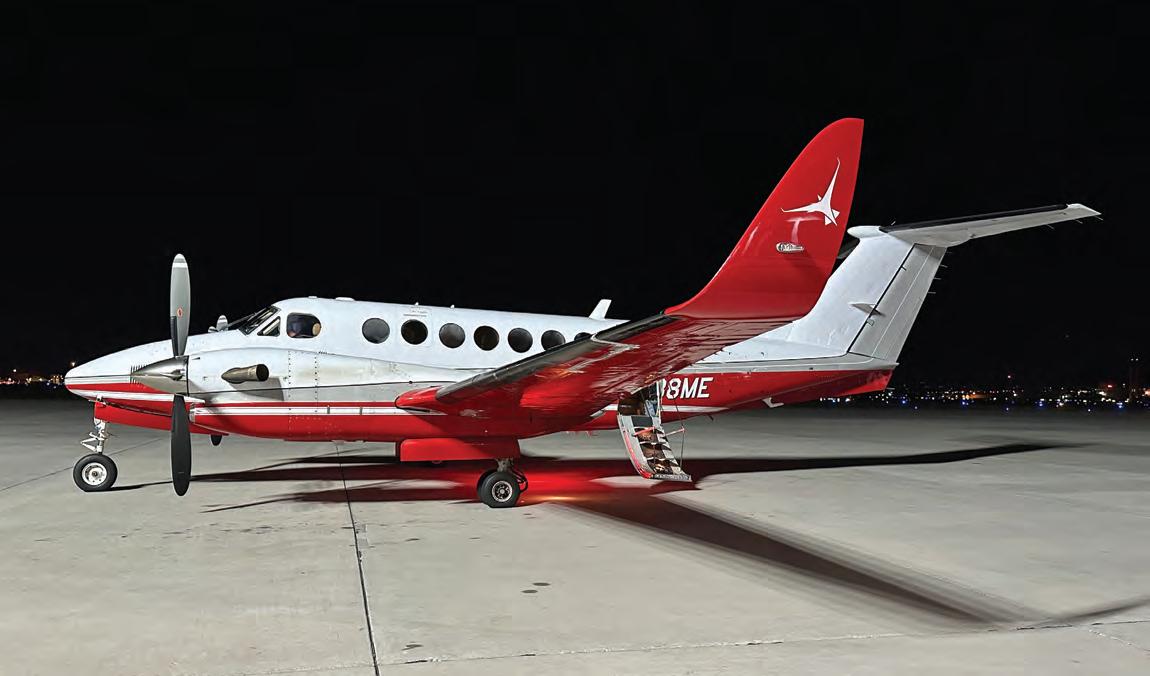 BY MATT THURBER
BY MATT THURBER
It was a long flight and a relatively slow flight, but the trip in a modified King Air 350 from Orlando to Albuquerque likely broke a city-pair record (official acknowledgment is pending), thanks to the active winglets installed by Tamarack Aerospace.
On the way to the static display at Orlando Executive Airport for last October’s NBAA-BACE event, Tamarack made the trip nonstop, from Spokane International Airport in Washington to Orlando. Pilot ed by Jesse Nonnemacher, the Performance SmartWing-equipped King Air 350 fle w 2,032.8 nm in 7 hours 46 minutes, averaging 240 ktas. Tailwinds averaging 20 knots helped propel the King Air
and allo wed for lower power settings to extend range. In addition to the OrlandoAlbuquerque flight, Tamarack has also submitted the Spokane-Orlando city pair trip to the National Aeronautic Association and European Federation Aeronautique International for record recognition.
Tamarack founder and CEO Nick Guida had planned to break a new city pair record on the way back from BACE, but this time from Orlando to Las Vegas. The King Air needed to fly to Henderson, Nevada, for some scheduled maintenance, and it was a good opportunity to try for another record.
On the last day of BACE, however, the winds at the King Air’s most efficient altitude (FL340/350) were extremely uncooperative. I joined the flight for the return trip, which was captained by Lorin Meyers, in part because I planned some time off in Las Vegas after BACE but also to experience first-hand what it was like to fly a citypair record flight.
Any aircraft can be flown in a city-pair record attempt, and there are various classes of aircraft that make the playing field fairly level. What made this King Air 350 unique and able to go for longer records, however, was the Tamarack SmartWing active winglets.
Adding winglets to any airplane increases the aspect ratio of the wing, which improves performance not only by reducing drag from wingtip vortices but also by allowing a climb to a higher initial and thus more efficient altitude. But the longer wingspan and winglets add aerodynamic loads to the wing, so the structure has to be strengthened. This adds weight and subtracts some of the efficiency improvement.
What makes Tamarack’s winglets different is the addition of its active technology load alleviation system (Atlas) active-camber surfaces (TACS) near the ends of the wings. The TACS actuate only to counteract an extra load when it happens, such as during turns or when encountering turbulence and gusts, and the rest of the time they sit passively, waiting for the next load to come along.
The Atlas system thus requires less structural enhancement, and in the CitationJet series produces efficiency improvements of up to 30 percent, allowing faster climbs to higher altitudes and longer range.
For the King Air 350, the SmartWing mod adds six feet of wingspan and dual TACS, which allow continuation of flight at normal speed with one TACS failed. In single-TACS installations, as on the CitationJets, pilots must reduce airspeed if a TACS fails because the aerodynamic loads are no
longer being alleviated.
After waiting for the BACE static display to clear out enough so we could depart on October 20, Guida and Meyers filed a hopeful nonstop flight plan to Henderson. We already knew that it was unlikely we’d mak e it that far with the required minimum fuel reserves, but perhaps the weather gods would relent once we got going. Sadly, it wasn’t to be.
We departed from Orlando Executive as the sun was setting, with a full load of 3,610 pounds of fuel onboard and weighing 13,000 pounds, 1,000 pounds under the airplane’s 14,000-pound mtow. The climb to FL350 took 32 minutes, and our flight plan took us from Florida over Alabama, Mississippi, Arkansas, Oklahoma, and Texas. The Garmin G1000 avionics gave Meyers and Guida plenty of real-time information on the progress of our flight, which we were all tracking on ForeFlight as well (I used ForeFlight’s Sentry Plus ADS-B receiver to monitor the weather and our progress).
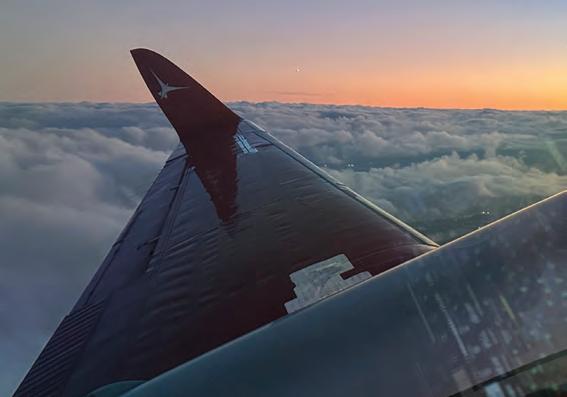
Almost immediately, it became obvious that the strong winds aloft weren’t going to allow the 1,804-nm nonstop flight to Henderson. The outside air temperature at altitude was slightly warmer than normal but not enough to affect performance

much. After leveling off, fuel consumption stabilized at 250 pph for each of the Pratt & Whitney Canada PT6 engines, and later during the flight this dropped to 210 pph.
Our groundspeed showed how much the wind was holding us back. Early in the flight, we dipped down to 198 knots. As the King Air droned on and on into the night, the wind occasionally let up and our groundspeed peaked at 267 knots, but not for long enough to allow us to fly much farther than Albuquerque.
Just before we began descending for our unplanned fuel stop at Albuquerque, groundspeed had dropped to just 190 knots.We landed at Albuquerque with 500 pounds of fuel, a decent reserve for the clear weather, having flown 6 hours 24 minutes and 1,400 nm. The fine line crew at Cutter Aviation quickly refueled the aircraft and we were soon back in the air for the 1-hour, 44-minute flight to Henderson, this time at FL250. We landed well after midnight, and the FBO was closed. So we exited the ramp through the keycode gate.
Although it had been an extra-long trip, the Tamarack-modified King Air lived up to its performance promises and showed that the SmartWing modification extends the range of the twin turboprop. A stock King Air 350 wouldn’t have been able to make it to Albuquerque in those conditions. z
The vast majority of the nation’s heliports epitomize the “normalization of deviance,” according to Rex Alexander, a vertical flight infrastructure expert and the CEO of consultancy Five Alpha. “Just because somebody painted an ‘H’ in a parking lot does not mean that it meets any standard, anywhere,” Alexander counseled during a Helicopter Association International (HAI) webinar in January. The session occurred days after the FAA released its latest advisory circular (AC) on heliport design (see sidebar on next page).
Alexander noted that most of the nation’s heliports have design, lighting, marking, and airspace issues related to size, obstructions, and approach slopes and are antiquated. He also said that pilots have received no training or poor training on what constitutes a proper heliport/helipad. At the heart of the problem is the lack of proper regulation and the voluntary nature of heliport standards, he added.
“According to the FAA, there are 6,104 heliports on record in the U.S.,” Alexander said. “Fifty-seven of those, or 1 percent, are public use, and 6,047, or 99 percent, are what we refer to as private use. The FAA has absolutely no enforcement authority over private-use heliports. That means that 99 percent of the heliports in the U.S., the FAA can’t shut down. They can enforce operations, but not the infrastructure. There is no certification for heliports.” That includes all hospital heliports in the lower 48 U.S.

Another problem is that hospitals and other facilities do not properly future-size their heliports, Alexander said. “The first question we ask all of our clients is, ‘What is the largest helicopter that you’re intending to use at this facility? Not just today, not next week, but…in the next 10 to 20 years?’ And we base our design criteria on that geometry. We’re looking at the maximum
load and gross weight, what’s the overall length, tail rotor arc, undercarriage dimensions, and so forth.” Alexander noted that w hen the Maryland State Police, which routinely flies medevac missions, upgraded from the Airbus AS365 to the Leonardo AW139, the weight and dimensions of the latter meant that several hospital helipads in the state could no longer be used.
While heliport standards are voluntary for private-use facilities, there is guidance mentioning “airport operations” for Part 135 operations, rules that govern most air ambulance operations in the U.S. But the guidance is imprecise and murky at best, Alexander said. “No certificate holder may use any airport unless it is ‘adequate,’” he noted. “Now, that’s a very subjective word,
and I could ask 10 pilots what adequate is and get 10 different answers but when we’re looking at this, it’s adequate for the proposed operation, considering things such as size, surface obstruction, and lighting. So, they do give you criteria, but what is adequate is very subjective and we’ve seen that somewhat misused in the Part 135 world.”
Pilot training is the other missing link, Alexander said, noting that the Helicopter Flying Handbook, the Helicopter Instructor’s Handbook, and other relevant literature contain nothing about proper infrastructure save for a passing reference to the lighting in the instructor text. “We don’t test pilots. So, pilots do not get an education on what infrastructure is supposed to look like. When they’re presented with infrastructure that
For 50 years, AIN has provided market-leading coverage of the most important airshows and conventions across the globe. In 2023, AIN is expanding its coverage with more events and more marketing opportunities. Drive awareness and consideration with a 360-degree marketing plan including print (where available), newsletters, and digital. Custom content opportunities are also available across all of our platforms.

January: Schedulers & Dispatchers | March: *Heli-EXPO, Sun n’ Fun, AEA | April: AERO Friedrichshafen
May: *EBACE | June: *Paris Air Show, Aircraft Interiors Expo | July: EAA Air Venture

August: LABACE | October: *NBAA-BACE | November: *Dubai Air Show
Learn more at: marketing.ainonline.com/airshows-conventions
is substandard, they don’t know any better. We haven’t taught them when to say ‘no.’ I always tell people that pilots generally don’t read advisory circulars, and that’s where all of this information is, generally.”
But pilots would be well-advised to expand their knowledge on the topic, Alexander said. “I always tell pilots, just because you can land there, it doesn’t mean you should. Because when something gets broken and you bend metal, that’s your license on the line. It’s very, very rare that the operators are held responsible, or the owner of the infrastructure is held responsible. It’s always the pilot. The NTSB does that routinely. I wish they wouldn’t.”
Alexander knows better, however. “In 2009, I was one of the parties involved in the NTSB HEMS [air ambulance] accident hearings. I remember bringing up heliports and was told, ‘It’s not a big deal, it’s not a problem.’ It was never identified because nobody was investigating it correctly. We don’t have good documentation, so we can’t learn from our past screw-ups.
That is something we’re trying to change.”
And the price of bad infrastructure design can be expensive, even for minor scrapes such as tail-rotor strikes, which can cost up to $400,000, he said. “By the time you get the components replaced, [pay for] all the AOG shipping, all the out-of-service time, and all the extra manhours, it gets real expensive really quick. I can build you a heck of a heliport for $400,000. You know, that’s the disparity.”
Continued Alexander: “What’s the safe thing to do? What’s the right thing to do? You should follow the minimum standards [in] that Advisory Circular the FAA publishes.” And that applies to both pilots and those responsible for the infrastructure, particularly hospitals, Alexander said.
He finds it ironic that “most states have a requirement in place that helicopter air ambulance [programs] teach first responders how to set up and design landing zones f or scenes—how big, how to mark them, and communications” but yet “there is no standard in place that asks that we teach
hospitals anything” with regard to helipad/ heliport design.
But the new AC, coupled with mandated safety management systems (SMS) for Part 135 operators, improved state regulations, and the forward march of advanced air mobility, could eventually change that. Wider promulgation of some state rules could show the way toward a solution.
“On the regulatory side,” he concluded, “I think there’s the opportunity to come up with something that [some] states have been using for years—and that’s commercial. It [the heliport/airport] may be private, but if you’re doing commercial operations, the state says you need to meet a higher standard. I think the FAA would be wise to look at adopting some additional categories [in addition to private and public use], commercial being one of those. SMS is r equired for an airport, required for Part 121 [air carriers]. Soon it will be required for [Part] 135 operators. It makes sense I think, to have it required for vertiports.” z
The FAA issued its new and long-awaited heliport planning, design, and construction Advisory Circular 150/5390-2D that provides largely voluntary guidance to the rotorcraft community. This new AC supersedes previously issued guidance from 2012. The FAA notes that “the standards and guidelines contained in this AC are practices the FAA recommends for establishing an acceptable level of safety, performance, and operation for heliports.”
However, it does not cover advanced air mobility (AAM) or eVTOL operations. Rather, the FAA notes that it is “developing guidance for vertiports that would be intended for VTOL and/or unmanned aircraft. Until that guidance is published, entities developing operating sites for new aircraft entrants are encouraged
to work with the FAA Office of Airports and Flight Standards on applicable design, operational, and safety criteria tailored to the performance of aircraft which intend to operate at those facilities.”
Provisions of the AC are only mandatory if certain federally-funded programs are used to fund the heliports. Those programs include federal grant assistance programs, including but not limited to the Airport Improvement Program (AIP) and Coronavirus Aid, Relief, and Economic Security (CARES) Act Airport Grants program or projects funded by the Passenger Facility Charge (PFC) program. The AC has no applicability under Part 139 airport certification due to an exemption for heliport operators per FAR 139.1(c)(5). The FAA adds, “Other federal
agencies, states, or other authorities having jurisdiction over the construction of heliports not funded with AIP, CARES Act, or PFC funds have discretion in establishing the extent to which these standards apply.”
Principal changes contained in the new AC include a new organizational structure of the material contained therein covering general aviation, transport, and hospital heliports; heliport gradients and pavement design; taxiways, taxi routes, and parking; markings and lighting; site safety elements; pre-designated emergency landing areas; and perimeter lighting for VFR operations. New dimensional, layout, and offset requirements also are included, as is a “heliport evaluation process flow chart.”
M.H.





































Embassair, a new FBO at Miami Opa-locka Executive Airport (KOPF), opened on February 1 after two years of construction. The $50 million complex, now the fourth service provider on the field, was designed by architect Jacques Rougerie and its 25,000-sq-ft terminal features four private boarding lounges with direct access to the ramp; a covered garage with access to the lounges and ramp; an atrium lobby with a 28-foot-high ceiling; dining lounge; a trio of snooze rooms with individual bathrooms, full beds, and television; crew gym; two flight-planning areas; and a pair of conference rooms seating four and eight, respectively. The AEG Connect-branded facility has 60,000 sq ft of adjoining hangar space and nearly three acres of ramp space.

Aviation holding company SAR Trilogy, which operates the Aero Center FBO chain, is expanding into the Atlanta market via a definitive purchase agreement for familyowned Epps Aviation, a full-service FBO at DeKalbPeachtree Airport (KPDK). The transaction is expected to close this month, pending necessary approvals.
One of three service providers at KPDK and the only independent on the field, Epps has been in operation for nearly 60 years, led by Pat Epps and his three children. The 18-acre facility includes a 7,000-sq-ft, two-story terminal with a passenger lobby, refreshment bar, pilot lounge with a snooze room and showers, flight-planning area, two conference rooms, tenant offices, and concierge service. The FBO also has 220,000 sq ft of hangar space. Additionally, the purchase includes Epps’s Part 135 charter certificate and Part 145 repair station, giving the Aero Center chain its first exposure in these areas.
Sheltair will expand its service network in Georgia with the announcement that it has been selected by Gwinnett County Airport (KLZU) to take over the FBO location formerly operated by Gwinnett Aero, whose lease has expired. Floridabased, family-owned Sheltair was chosen at the completion of a request-for-proposal process for the $17 million project, which will include the construction of a new FBO terminal and hangar as well as the rehabilitation of existing hangars.
The company will begin operations on April 2 from the existing facility as an Avfuel-branded location. Sheltair was awarded a 40-year lease on the property at the state’s thirdbusiest airport, which saw 119,000 operations last year.

Global aviation service provider Jetex Flight Support has unveiled its first entry into the UK market: an FBO at dedicated business aviation gateway London Biggin Hill Airport (EGKB). Formerly home to the Signature Flight Support location and before that Rizon Jet—the 1,900-sq-m (20,500-sq-ft), two-story facility offers passenger and crew lounges, showers, conference rooms, on-site UK customs and immigration, concierge services, prayer room, direct ramp access, and fueling coordination. Its 40,000-sq-ft hangar can accommodate ultra-long-range business jets.
The opening of the FBO follows EGKB’s busiest year ever, with more than 26,000 movements in 2022. It claims a 23 percent share of the UK capital’s private aviation activity with its location just nine miles from the Canary Wharf business district and 15 miles from Central London. Its 1,806-meterlong (5,925-foot) runway allows most private aircraft to operate without restriction, including transatlantic flights.
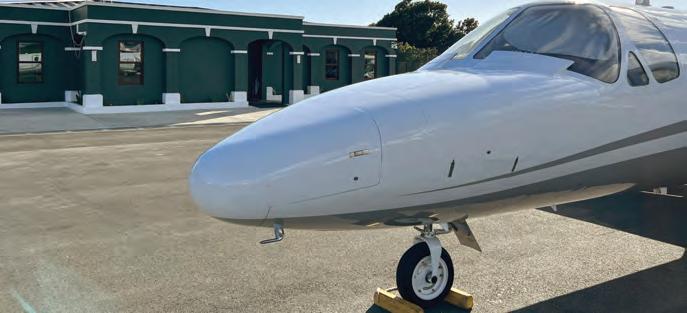
On Sept. 20, 2017, Hurricane Maria, one of the most devastating and costly storms to hit the Caribbean, passed near the U.S. Virgin Islands and destroyed much in its path, including the Bohlke International Airways FBO, the lone service provider at Henry E. Rohlsen Airport (TISX) on St. Croix.
While its facility was destroyed, the company swiftly pivoted and received permission to occupy a vacant, less-damaged facility to the east of its existing leasehold, where it set up shop. Bohlke remained there for the next five-plus years while it wrangled with insurance providers and architects on a replacement facility.
In January, the new 4,400-sq-ft terminal finally opened with one of the reconstructed FBO’s first guests being President Biden and his family, who arrived on Air Force One.
“We went for a full audit and passed with flying colors,” said company president William Bohlke, a third-generation professional pilot and the third generation to operate the FBO over its 64-year history. “Air Force One takes its procedures very seriously, everything was inspected, and our fuel was lab tested in the States. I think we raised the bar as a company to be able to fulfill their needs.”
While the sight of a 747 may be rare on St. Croix (Bohlke, who grew up at the airport, doesn’t remember the last time he saw one there), large military aircraft such as the C-5 Galaxy, C-17 Globemaster III, C-130 Hercules, and P-3 Orion are common visitors at TISX with its 10,000-foot runway.
The $5 million terminal is located at the far eastern end of the field. It includes a wellequipped kitchen area, passenger lobby, 12-seat a/v-equipped conference room, pilot lounge, snooze room, shower facilities, laundry, and dishwasher. Onsite car rental and crew cars are available. It was built on one of four leaseholds the company has at TISX,
including the plot where its former terminal and hangar once stood. As part of the negotiations ahead of the recent construction, Bohlke was able to consolidate the four plots into one long-term lease.
While nearby St. Thomas (a 12-minute flight) caters more towards the leisure end, St. Croix is considered more the “industrial island,” and the mix of aircraft there reflects that with a steady flow of light cargo haulers such as Caravans and Skyvans. Medevac operations are also a key segment, and the company operates a trio of speciallyequipped Citations, along with a pair of Falcon 900s and a Mitsubishi MU-2.
“What drives a lot of the corporate traffic in my opinion is yachting, the big boats, and we just don ’t have a lot of that here,” Bohlke told AIN , adding that the island lacks the marina infrastructure to cater to the large, ocean- g oing vessels that form the backdrop of many other islands in the Caribbean. That, however, has turned TISX into somewhat of a sleeper for private aircraft heading to the mainland U.S. with passengers and crews who must clear customs—even U.S. citizens. “[TISX] is the preferred place for customs simply due to the fact that we don’t have the crazy amount of
corporate traffic that other islands have so there is less congestion,” said Bohlke. “The ones that have gotten smart are starting to come to us.”
The company has 42,000 sq ft of enclosed hangar space, ranging from the 22,000-sq-ft structure adjacent to the new terminal that boasts 50-ft-high doors to an 8,000-sq-ft hangar next to its temporary terminal and a recently-refurbished 12,000-sq-ft maintenance hangar at the far western end of the field. Bohlke also has a 12,000-sq-ft open hangar. Plans call for the construction of an additional 40,000-sq-ft hangar within the next two years.
The Avfuel-branded FBO—which was recently renamed Bohlke International Aviation—also offers aircraft management, charter, and maintenance. It is open every day from 7 a.m. until 7 p.m. with after-hours callout available. Between all of its divisions, the company employs 83 people. The line staff undergoes NATA Safety 1st training, while the CSRs use its fuel provider’s in-house customer service training program.
As the into-plane agent for airport fuel provider Puma, Bohlke performs all the aircraft fueling on the field, including commercial flights. C.E.
Barrington Irving, the founder and CEO of Flying Experience and The Flying Classroom, detailed plans for a new aviation technical training center at Miami-Opa locka Executive Airport (KOPF). The Oliver G. Gilbert III Innovation Lab, named after the current Miami-Dade board of county commissioners chairman, is set to open this summer at KOPF.

The U.S. Air Force plans to fly its Gulfstreams for a while longer. On January 27, the Air Force announced that Gulfstream Aerospace had been awarded a variety of contract modifications to support the service’s fleet of C-20 and C-37 (Gulfstream III, IV, V, and 550) models. The modifications have a combined value of $124 million.
The awards include an $87 million modification for contract logistics support services, bringing the cumulative value of the contract to $594 million, and $37 million for C-20 and C-37 engineering support contract services, bringing the cumulative value of that contract to $612 million. All work will be completed by Jan. 31, 2025, and Jan. 31, 2031, respectively. It will be performed in Savannah, Georgia; at Joint Base Andrews in Maryland; Hickam Air Force Base in Hawaii; and Ramstein Air Base in Germany. It is being contracted by the Air Force Life Cycle Management Center at Tinker Air Force Base in Oklahoma.
Duncan Aviation has opened a fixed avionics support shop at Long Island's Republic Airport in Farmingdale, New York. The move comes at the request of the MRO’s customers as demand in the region had increased since closure of its satellite location at nearby MacArthur Airport in 2008, Duncan Aviation said.
The Republic Airport shop is in Atlantic Aviation’s hangars, and Pete Marte, a nearly 20-year Duncan veteran, is managing the operation in addition to Duncan Aviation’s satellites in Oxford, Connecticut; White Plains, New York; and Bedford, Massachusetts. Satellite avionics tech Pedro Roque is leading a team that will include Naimul Islam in the upcoming months. They will support Duncan Aviation customers, as well as drop-ins at the airport.
The goal of the facility is to help students gain technical skills that enable them to have careers in business aviation, but which are also transferable to other fields. Irving told AIN that technical training at the lab will include line service skills such as tanker and tug operation, GPU utilization, lav servicing, and aircraft marshalling, as well as advanced remote pilot operations and aircraft maintenance.
Yingling Aviation has added its 13th hangar at Wichita Eisenhower National Airport (KICT) to accommodate the expansion of its MRO activities. The FBO/MRO acquired the 22,000-sq-ft hangar located at the north end of KICT.
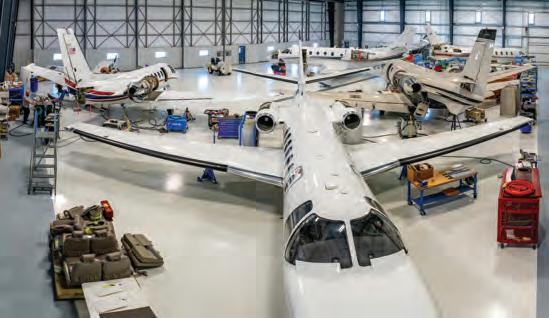
The building features two levels of office and hangar space. Additionally, Yingling will be hiring more than 20 employees with the expansion—airframe and powerplant mechanics, avionics technicians, and program managers.
“The fact that Yingling has flourished during the pandemic and after is proof that our dedication to superior technical support and customer service leads to success and growth,” said Yingling president Andrew Nichols. “The rate of increase of new customers and percentage of repeat business makes everyone at Yingling very, very proud. As we continue to expand our capabilities and support, in response to strong customer demand, this hangar was the perfect solution to ensure our customers continue to receive world-class service.”
StandardAero closed on the purchase of Van Nuys, California-based Gulfstream maintenance specialist Western Jet Aviation on February 1. The acquisition is StandardAero’s 12th since 2015 and adds significant G ulfstream airframe MRO capability, with more than 120,000 sq ft of hangar, shop, ramp, and office space on a 10-acre facility, nearly 100 personnel, and Western Jet’s avionics and interior shops.
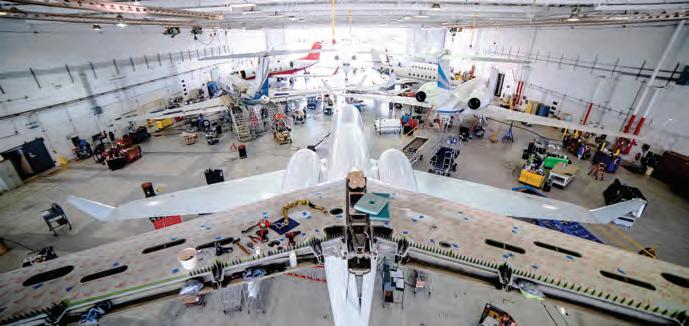
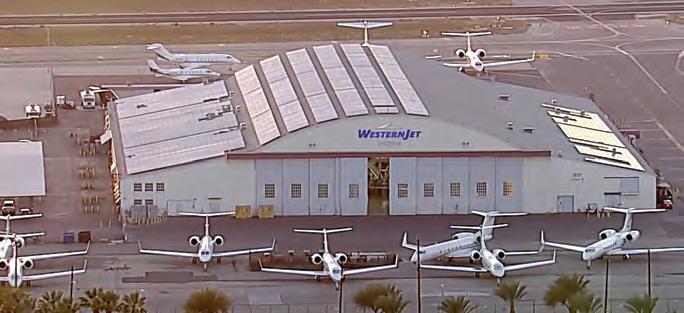
The move also marks a return to the West Coast for StandardAero, which previously operated an MRO facility at Los Angeles International Airport (KLAX) but closed it in 2018. “When we departed LAX, we’d been looking for a location on the West Coast,” said Colleen Back, StandardAero senior commercial director, airframe, who is heading up the integration efforts for the acquisition. “Van Nuys is one of the busiest business aviation airports in the country, and this will add a large Gulfstream footprint to the company.”
Western Jet founder and owner Jim Hansen said the sale of his company, which he opened in 1999, was bittersweet, but he is excited about the opportunities. He has worked at Van Nuys Airport for the past 50 years, starting as a mechanic for the Jet Center and other companies before opening Western Jet. Hansen plans to stay with StandardAero as an executive consultant.
“After nearly 50 years in aviation, it was time for me to pass the reins,” he said. “We have accomplished so much at Western Jet, but it was also time to find the right partner to help Western Jet go to the next level. StandardAero is the perfect partner to help this company do just that. I am thrilled for the employees and for the future of this company.”
Western Jet has grown into a large independent Gulfstream maintenance company, with comprehensive maintenance available on the G200 and GIV through G650
models, as well as avionics installation and repair, which opened in 2009, and more recently interior refurbishment. In addition to airframe line and heavy maintenance, Western Jet can perform line maintenance on Rolls-Royce Tay, Spey, BR710, and BR725 engines, and service Honeywell 36 and RE220-series APUs. Western Jet holds FAA and EASA repair station certificates and many OEM approvals.
StandardAero, which is owned by investment firm Carlyle, now has business aviation MRO locations that span the U.S., with major airframe facilities in Springfield, Illinois, and Augusta, Georgia. The purchase of Vector Aerospace in 2017 added engine MRO in Europe , and this was followed by the acquisition of Signature Aviation’s engine
repair and overhaul business in 2021. The new West Coast facility, to be called Western Jet Aviation, a StandardAero company, will continue the Western Jet Academy, which invites new mechanics to work in a paid apprentice program to gain experience and earn certification.
“Western Jet Aviation’s broad range of business aviation MRO capabilities expands our facility footprint, customer base, geographic reach, and repair portfolio to facilitate continuing growth for StandardAero,” s aid Russell Ford, chairman and CEO of StandardAero. “Organizationally, Western Jet Aviation will be aligned with our business aviation division and we warmly welcome the Western Jet Aviation team to StandardAero.” M.T.
Embraer EMB-505, Jan. 2, 2023, Provo, Utah
The pilot was killed, two passengers survived with serious injuries, and a third escaped with minor injuries after the light jet’s left wing struck the runway just after takeoff. Witnesses described the airplane lifting off in a steep pitch attitude and reaching an altitude of 20 to 30 feet before the wings “wobbled back and forth,” rolling right and then hard left until ground contact. Scrape marks found on the runway indicated that the airplane briefly lifted again before departing the runway to the left, leaving an impact crater at the beginning of a 597-foot debris path that led to the final resting point of the fuselage. Both wings separated and were found another 106 feet further along. Both engines had separated and were found adjacent to the fuselage.
The airplane had been hangared before the flight, but was pulled out for refueling at about 10:55 MST. The lineman who serviced it with 350 gallons of jet-A recalled the pilot telling him that he was “trying to get out before the weather;” the lineman also noticed unfrozen water droplets on the wings. The pilot started the engines around 11:10 or 11:15, about the time light snow began to fall. The lineman described the precipitation as a mixture of snow and misty rain of light to moderate intensity. The last recorded weather observation showed calm winds, an 800-foot overcast, and three miles visibility with both temperature and dew point at -1 deg C.
The accident closed Provo Municipal Airport for three days. It took investigators
23 hours to reach the scene, by which time four to six inches of snow had fallen. However, they were able to identify an initial scrape mark 2,626 feet from Runway 13’s approach end that ran 91 feet parallel to and about 20 feet left of the runway centerline. A second scrape mark began 2,903 feet from the centerline and arced left toward the impact crater.
Piper PA-46-350P JetProp DLX, Jan. 17, 2023, Yoakum, Texas
The pilot, co-pilot, and two passengers were all killed when the single-engine turboprop crashed about one mile short of the threshold of Runway 31 of Yoakum Municipal Airport (T85). A third passenger escaped the wreckage with serious injuries and was able to summon emergency responders via cellphone.
The accident occurred at the end of a Part 91 business flight from Memphis (Tennessee) International Airport. Prevailing weather at the site included clear skies and 10-mile visibility with six-knot southeast winds.
The 2008-model Piper Malibu was originally furnished with a 350-hp turbocharged Lycoming piston engine but was retrofitted with a Pratt & Whitney Canada PT6A-35 turboprop engine i n 2020.
It departed Memphis at 07:48 CST on an IFR flight plan to T85 and was eventually cleared for the RNAV (GPS) approach to Runway 31. ADS-B data showed that about one mile from the runway threshold the airplane turned to the right and descended into the ground. It came to rest upright, and though both wings separated from the fuselage, there was no post-impact fire.
Raytheon 400A, Nov. 1, 2020, Fernandina Beach, Florida
The flight crew’s failure to break off their landing approach after recognizing that the reported headwind had shifted to a strong, gusty tailwind led them to touch down on a wet 5,152-foot runway at a groundspeed in excess of 120 knots. One of the four passengers sustained minor injuries when the airplane ran off the departure end of Runway 13 and came to rest in grass and soft soil about 150 feet beyond the threshold, separating the nose gear and causing substantial damage to the nose, deformation of the forward pressure bulkhead, foreign object damage from mud ingestion to both engines, and damage to the left wing.
The Part 135 charter flight had departed from Naples, Florida for Fernandina Beach (KFHB) just under an hour earlier.
While still en route, the pilots were advised of moderate to heavy precipitation for the next 1.5 miles and a second ar ea of moderate to heavy precipitation passing over KFHB. The pilots requested and were cleared for a descent to 2,500 feet, which found them still in instrument conditions. Reported winds were from 110 degrees at 4 knots with gusts to 18, so they requested and received clearance for the RNAV approach to Runway 13.
After extending the gear and flaps and completing the before-landing checklist, the pilot said, “We’ll probably just go hold for 15 minutes and try it again,” to which the co-pilot replied, “Yeah, you got a 22-knot tailwind,” having apparently read that from one of the instrument panel’s
flight displays. However, they continued the approach.
The pilot called the runway in sight 300 feet above the minimum descent altitude, and the jet touched down on the centerline at its aiming point with engines at idle and at its reference speed of 110 knots. The flight data recorder logged its groundspeed at 121 knots.
The co- pilot de ployed the speed brakes, only to retract them six seconds later. The pilot said, “It won’t stop…it won’t stop. Hang on,” and called for the co-pilot to deactivate the anti-skid system, which he did in the last third of the runway. The co-pilot called for a go-around, but the pilot said he couldn’t and instead used S-turns on the runway to slow the airplane before it ran off the end. Post-accident examination found no anomalies in the br aking and anti-skid systems, which operated normally whe n tested.
Bell 206B-3, Feb. 15, 2021, St. Thomas, U.S. Virgin Islands
The ope rator’s failure to follow the manufacturer’s inspection schedule for “corrosive and/or erosive environments” was blamed for catastrophic blade fractures in the numbers 3 and 6 compressors, causing a complete loss of engine power. The pilot and all three passengers were killed when the helicopter crashed into a steep, wooded hillside on a short VFR sightseeing flight after the engine failed at an altitude too low for successful autorotation.
Investigators subsequently found that the 300-hour or 12-month inspection mandated by the engine manufacturer, which would have identified the damage to the compressors’ plastic coating that allowed moisture intrusion, had last been completed three years and 800 flight hours before the accident.
De Havilland Canada DHC-6 Twin Otter 300, Nov. 1, 2021, Fort Providence, Northwest Territory, Canada
A possibly misplaced fuel order and the captain’s reliance on cockpit flows in place of written checklists resulted in a rare case of total fuel exhaustion on a scheduled airline flight. Both pilots and their three passengers suffered mild hypothermia injuries during a four-hour wait for rescue after a forced landing into muskeg 6.7 nm from their intended emergency destination of Fort Providence Aerodrome (CYJP). The accident occurred on the last of the day’s seven scheduled legs following three round trips between Yellowknife (CYZF) and two outlying airports. Their schedule called for the crew to stay overnight after their final flight from Yellowknife to Fort Simpson (CYFS).
Investigators were unable to determine whether the crew followed their standard practice of contacting their flight coordinator to advise of fuel requirements while inbound on the last return flight, but no fuel order was ever placed. The Twin Otter landed at CYZF with approximately 533 pounds of fuel on board; the standard flight plan to CYFS specified a fuel supply of 2,500 pounds.
After deplaning with the passengers and then returning to the aircraft, the captain saw a fuel receipt in the map pocket and assumed it had been loaded for the upcoming flight; in fact, it dated from three days earlier. He ran through the Before Start checks via cockpit flow rather than consulting the printed checklist as the passengers boarded and the cargo was loaded. Unlike the day’s first few flights, the captain ran the After Start, Taxi, and Line Up checks from memory after the first officer briefed the passengers and took his seat.
The Twin Otter took off at 17:47 local time. At 17:50, the fuel company called
the flight coordinator to ask whether the airplane needed fuel and was told it had already departed. The flight levelled at its planned cruising altitude of 6,500 feet. At 18:13, the low fuel warning light for the aft tank illuminated; at that point, enough fuel remained for about 40 minutes’ flight at normal cruise power. Another 13 minutes passed before the crew noticed the light and realized they’d departed without sufficient fuel. With both their destination and departure airports now out of range, they identified CYJP as the nearest available airport and turned south, climbing to 7,000 feet. They contacted their flight coordinator, who relayed a suggestion from the company’s chief pilot to shut down one engine to conserve fuel.
At 18:34 the captain began drawing the remaining fuel from the auxiliary wing tanks, and at 18:38 he shut down the left engine, feathered its propeller, and reduced power on the right engine, initiating a slow descent. The airplane was about 11 nm from CYJP and descending through 3,300 feet at 18:47 when the right engine surged and flamed out. The crew feathered its propeller and pitched for the bestglide airspeed of 86 knots, slowing further to just above stall speed before touching down in the muskeg at 18:51 and coming to rest upright. A 406-MHz ELT signal was detected by the Canadian Mission Control Center shortly after, and rescuers reached the scene about four hours later. Postaccident examination of the aircraft found no usable fuel remaining. z
March 28, 2023
The FAA proposes to expand the Class C airspace at Luis Muñoz Marín International Airport in San Juan, Puerto Rico. There will be no changes to existing flight paths. Information gathered at a February 28 Zoom meeting will assist the FAA in the drafting of a notice of proposed rulemaking that will be published in the Federal Register. Comments on the meeting are due by March 28, 2023.
April 12, 2023
The FAA proposes to update and expand the requirements for safety management systems (SMS) to make them applicable to all certificate holders operating under the rules for commuter and on-demand operations, commercial air tour operators, production certificate holders that are holders or licensees of a type certificate (TC) for the same product, and holders of a TC who license out that TC for production. Charter and tour operators would be required to implement an FAA-approved SMS no later than two years after the effective date of the rule. Comments on the proposal are due by April 12, 2023.
April 14, 2023
This EASA notice of proposed amendment (NPA) seeks to mandate the installation of crash-resistant fuel systems into existing rotorcraft designs that are still in production and the retrofit of existing rotorcraft that are operated in EASA member states. The objective of the NPA is to mitigate the risks linked to a post-crash fire involving rotorcraft. Comments are due by Feb. 13, 2023.
May 31, 2023 and Nov. 30, 2023
The European Commission has delayed the onset of new passenger reporting requirements that were previously scheduled to
start on Sept. 30, 2022. EES (Entry/ Exit System), designed to replace the current system of manual stamping of passports with an electronic record, is now scheduled to start a transitional phase in May 2023. Manual stamping of passports will end in mid-August 2023, and the transitional phase will end in February 2024. ETIAS (European Travel Information and Authorization System) is an online pre-travel, and pre-boarding requirement applying to visa-exempt third-country nationals planning to travel to European states. It is expected to be implemented in November 2023.
June 2, 2023
The National Fire Prevention Association (NFPA) is granting a 24-month extension to the compliance deadline of its standards that call for airport fueling vehicle loading racks to be equipped with automatic shut off devices that are compatible with fueling trucks. This extension to June 2, 2023, applies only to airports that adopted the 2022 revision of NFPA 407. The original compliance date of June 2, 2021, still applied for airports ope rating under the 2017 revision.
June 7, 2023
The ADS-B Out requirement in Europe is Dec. 7, 2020, for aircraft receiving their certificate of airworthiness (C of A) on or after December 7. Aircraft that obtained their C of A between June 6, 1995, and Dec. 7, 2020,
must arrange for retrofits to meet the ADS-B Out mandate by June 7, 2023. Both deadlines apply only to aircraft with an mtow exceeding 5,700 kg (12,566 pounds) or having a maximum cruising true airspeed capability greater than 250 knots. Aircraft with a C of A dated before June 6, 1995 are exempt from European ADS-B requirements.
June 12,
By June 12, 2023, operators under Parts 91, 91K, and 135 must complete submissions of reports to the pilot records database (PRD) of all historical records concerning training, alcohol testing, qualification, proficiency, and disciplinary actions dating on or after Jan. 1, 2015. Final compliance date for reporting historical records before January 1, 2015, is Sept. 9, 2024. Also begin ning on Sept. 9, 2024, the Pilot Records Improvement Act ceases to be effective and will not be an available alternative to PRD for operators, entities, or trustees to which these regulations apply.
Aug. 1, 2023
As part of an interim final rule overhauling aviation maintenance technician school regulations (Parts 65 and 147), the FAA is transitioning from using the mechanic practical test standards (PTS) as the testing standard for obtaining a mechanic certificate. As a part of this transition, the FAA developed the mechanic airman certification standards (ACS), which adds task-specific knowledge
and risk management elements. The FAA will use the PTS as the testing standard until July 31, 2023. Starting Aug. 1, 2023, the FAA will use the ACS to conduct mechanic certification tests.

Due to continued supply chain impacts stemming from the Covid pandemic, the previously announced implementation dates for ADS-B Out in Canada are delayed beyond the original date of Feb. 23, 2023. As a result, the mandate will come into effect as follows: Class A Canadian airspace on August 10, 2023; Class B Canadian airspace on May 16, 2024; and Class C, D, and E airspace to occur no sooner than 2026. The new dates have been developed from stakeholder feedback regarding supply chain limitations and backlogs to acquire and install the appropriate equipment.

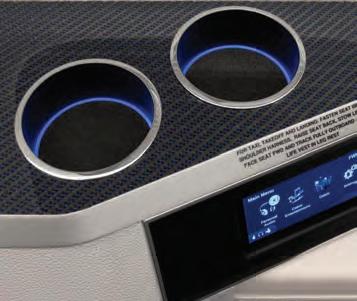

Starting on Dec. 2, 2022, EASA Part 145 maintenance organizations were required to meet revised regulations. However, there is a two-year transition period, to Dec. 2, 2024, to allow maintenance organizations to correct any findings of noncompliance with the new Part 145 requirements. The main change introduced in the new regulations is the required implementation of a safety management system (SMS). The SMS process requires Part 145 maintenance organizations to implement hazard identification systems, risk management and safety assurance processes, and the designation of a safety manager. To support the SMS process, several organization requirements have been changed including the safety policy, internal occurrence reporting, competence of staff, and compliance monitoring (replacing quality assurance).
For the most current compliance status, see: ainonline.com/cc

Joe Moeggenberg was appointed CEO of Levo. Moeggenberg, who has more than 40 years of aviation industry experience, previously founded American Air Services, which ultimately became Executive Jet Management (EJM), and then served as its president and CEO and later president of NetJets. After leaving NetJets in 1995, Moeggenberg formed Argus International, where he was president and CEO.

JetNet appointed Derek Swaim CEO. Swaim, who has served as president and a member of the board of directors at JetNet since joining the company five months ago, previously served as an executive-in-residence at Silversmith Capital Partners; executive v-p of corporate development at Validity; managing director at Aeris Partners; and investment banking roles at Harris Williams and Goldman Sachs.

Air Charter Service (ACS) appointed Joel Fenn as CEO of its new office in Washington, D.C. Fenn, who joined ACS in 2005, has held roles as private jets director in the London and Hong Kong offices and most recently served as CEO of its Miami operation.
Lilium appointed Oliver Vogelgesang CFO and Sebastien Borel chief commercial officer. Vogelgesang has nearly 30 years of finance and aerospace experience, most recently as managing director of finance at Airbus Germany. Borel joined Lilium in 2021 as v-p of business and was appointed senior v-p of commercial in 2022.
Suresh Narayanan was appointed COO at JSX . Narayanan has served as president and on the board of Aerospace Quality Research & Development since its inception and has invested in multiple Part 145 and 135 aviation businesses.
Mel Solomon was appointed president at GE Honda Engines. Solomon has more than 25 years of aviation experience and has previously held senior leadership positions in program management, marketing, and customer service at GE Honda, as well as technical and


commercial leadership positions at Bombardier.
Volato named Joan Sullivan Garrett to its board of directors. Garrett is founder and chairman of safety solutions provider MedAire. She was also inducted into the National Aviation Hall of Fame in 2021. Additionally, Norm Katz was appointed executive v-p of sales. Katz has served as v-p of sales at JetSuite Air and as a senior executive at both NetJets (Marquis Jet) and Sentient Jet. He also has held roles with Gartner, Hackett Group, i2 Technologies, Dun & Bradstreet, and most recently as COO and founder of CuraPatient, a healthcare IT firm.
The National Aviation Hall of Fame’s board of trustees elected James Cooling as board chair and Douglas Schwartz vice chair. Cooling is the founding partner of aviation law firm Cooling & Herbers. Schwartz has more than 40 years of experience in aviation management, strategic planning, flight operations, operational risk management, flight crew training, and aviation human factors. Since retiring in 2016, he has continued as an independent consultant at Cardinal Aviation Advisors.
Leo Knaapen joined the International Business Aviation Council (IBAC) as head of the organization’s industry partner program. Knaapen steps into this role upon retiring from Bombardier at the end of 2022 after more than 30 ye ars with the Montrealbased airframer.
Suzanne Markle —president and CEO of Pittsburgh Institute of Aeronautics—was elected as a member of the board of The Aviation Technician Education Council for a four-year term. Markle is also a member of the nomination committee for the National Aviation Hall of Fame and the DOT’s Women in Aviation Advisory Board.
Wayne Fry, the FAA flight standards division manager for general aviation safety assurance, has been named as government co-chairman of the U.S. Helicopter Safety Team. Fry is a 25-year veteran of the FAA and previously worked for 17
years at oil-and-gas industry helicopter operator Air Logistics.
The International Aircraft Dealers Association (IADA) named Stan Kuliavas, v-p of sales and business development for Levaero Aviation Group, head of its International Committee. Kuliavas replaces Zipporah Marmor , v-p of aircraft transactions at ACASS, who was named chair of the organization in October 2022 and formed the International Committee.
Brandon Steele was appointed by Leviate Air Group as regional v-p of aircraft sales in Florida. Steele joined Leviate following a career as a charter broker where he negotiated close t o $500,000 in charter sales with the company.

Chapman Freeborn appointed Alex Rincker senior v-p of aircraft, crew, maintenance, and insurance for the Americas. Rincker previously was a senior account executive for Air Planning in Tulsa, Oklahoma, and the manager of business development for Omni Air International.

Citadel Completions appointed Neil Boyle senior v-p of operations and GM. Boyle has four decades of aviation experience, including with the U.S. Air Force, Gulfstream Aerospace, and Jet Aviation, where he retired as senior v-p and GM.
Daniel Hickey was hired by Embraer as v-p of government relations for North America. Most recently, Hickey served as the director of government affairs at 3M Company and has worked at the Department of Transportation and FAA.
Claude Hurley, a former Transport Canada official and permanent representative of Canada to the International Civil Aviation Organization Council, has taken the role of director of environment and flight operations for the International Business Aviation Council.
The National Gay Pilots Association (NGPA) appointed Justin Ellixson-Andrews executive director, succeeding former NGPA president Brian Gambino. Ellixson-Andrews is a long-time member of NGPA and previously served as the head of talent acquisition and learning development at JSX.
Blueberry Aviation appointed Jon O’Connell as commercial director for
the Asia-Pacific region. O’Connell has more than 30 years of experience in aircraft leasing, trading, finance, marketing, technical evaluation, and management, most recently as Dubai-based CCO for DAE Capital.
Bombardier promoted Étienne Côté to chief pilot for demonstration flight operations. Côté has worked at Bombardier for 15 years in various functions including flight ops, investigation, human factor research, training, flight testing, and cabin services. He most recently held the position of demonstration pilot in the flight operations team.
Asian Sky Group (ASG) named Dennis Lau as consultancy services director. Lau has more than 15 years of experience working in both business and commercial aviation and joins ASG from Ascend by Cirium. z

Russ Lawton, who played an instrumental role in the development of the Air Charter Safety Foundation (ACSF) and efforts such as the organization’s Aviation Safety Action Program (ASAP), died on January 14 after a prolonged illness. He was 70.
Most recently v-p of operations for ACSF, Lawton was the organization’s first employee, joining in 2006 as director of safety management. In that role, he developed the Industry Audit Standard for air charter and fractional operators. Lawton also formed a strong partnership with the FAA to bring ASAP to Part 91 and 135 operations.
Lawton’s tenure with ACSF capped off a 40-year safety career in which he served on an aviation rulemaking committee to develop safety management system (SMS) requirements, was a member of the FAA ASIAS General Issues and Analysis Team, and was an active participant in NBAA’s Safety Committee.
Before joining ACSF, he was director of operations for Wyvern Consulting, served as an analyst and consultant for Events Analysis & Advanced Aviation Concepts, and was v-p of operations for the Aircraft Owners and Pilots Association (AOPA) and its AOPA Air Safety Foundation.
FSF honored Lawton with the 2022 Business Aviation Meritorious Service Award for his outstanding service and contributions to corporate aviation safety.
Grande Airport on a planned flight back to base at San Fernando Airport after two ambulance flights earlier in the day. Both pilots and two medical personnel were killed. Video footage shows the twinjet rolling left and descending before it hit the ground.
The pilot and three passengers aboard a privately-operated, Austrian-registered Cessna Citation II/SP are presumed dead after the aircraft departed Spain’s Jerez-La Parra Airport, continued past its planned destination of Köln/Bonn Airport, Germany, and fell into the Baltic Sea near Latvia on Sept. 4, 2022, some five hours after taking off. Pilots of military jets scrambled to intercept the bizjet but could not observe anyone in the Citation’s cockpit. On Dec. 30, 2022, two pilots were killed when their Mexico-registered Bombardier Challenger 600 crashed while enroute near Venado, Mexico.
In an uptick of accidents involving business turboprops, 37 died in 11 mishaps of N-numbered propjets last year compared with 23 deaths from 10 accidents in 2021.
The deadliest crash of an N-numbered turboprop in 2022 involved a float-equipped de Havilland Canada DHC-3T single-engine Turbine Otter that plunged into Puget Sound, Washington on September 4 during a Part 135 sightseeing flight. The pilot and all nine passengers died.
The nine fatal accidents involving non N-numbered business turboprops in 2022 was one more than in 2021, but the number of fatalities decreased from 40 in 2021 to 26 last year. One of the fatal crashes in 2022 of non U.S.-registered turboprops occurred to the recently manufactured final production Pilatus PC-6 Turbo Porter. On December 15, the new single-engine turboprop crashed into the sea while climbing out fr om Crete’s Heraklion Airport during its planned delivery flight to Indonesia. The crash killed one of the two occupants. Just three-days earlier the Swiss manufacturer had officially handed over the aircraft to charter operator Smart Aviation of Jakarta. z
JAMES HOLAHAN (1921-2015), FOUNDING EDITOR, WILSON S. LEACH, FOUNDER & CEO
EDITOR-IN-CHIEF – Matt Thurber
NEWS EDITOR–AIN PUBLICATIONS – Chad Trautvetter
EDITOR AIN MONTHLY MAGAZINE – Kerry Lynch
SENIOR EDITORS – Charles Alcock – AIN/FutureFlight.aero, Curt Epstein, Gregory Polek – Air Transport, Int. Show Editions, Jerry Siebenmark, FutureFlight.aero writer/editor Hanneke Weitering
COPY/SOCIAL MEDIA EDITOR – Kait Wilson CONTRIBUTORS
David Donald – Defense, Mark Huber – Rotorcraft , Jennifer Leach English, David Jack Kenny – Safety
Gordon Gilbert, Richard Pedicini, James Wynbrandt
PRODUCTION MANAGER – Martha Jercinovich
GRAPHIC DESIGNERS –John A. Manfredo, Grzegorz Rzekos
DIRECTOR OF VIDEO – Ian Whelan
CHIEF OPERATING OFFICER – Dave Leach
PRESIDENT - Ruben Kempeneer
VICE PRESIDENT SALES & MARKETING – Karl H. Elken
SENIOR DIRECTOR, INDUSTRY AFFAIRS AND EVENTS– Nancy O’Brien
ADVERTISING SALES
Michelle James – Midwestern U.S., Western U.S./Western Canada/Asia Pacific, +1 (520) 343-0236
Joe Rosone – Mid-Atlantic U.S./Southeast U.S./Caribbean/Brazil, +1 (301) 693-4687
Diana Scogna – Europe/Middle East, +33 6 62 52 25 47
Victoria Tod – Northeastern U.S./Eastern Canada/Great Lakes U.S./United Kingdom, +1 (203) 733-4184
Yury Laskin – Russia, +7 05 912 1346
AUDIENCE DEVELOPMENT DIRECTOR – Eileen Silberfeld
DIRECTOR OF MARKETING AND CLIENT SERVICES – Lisa Valladares
SOCIAL MEDIA MARKETING – Zach O’Brien
SALES ADMINISTRATOR – Cindy Nesline

DIRECTOR OF FINANCE & HUMAN RESOURCES – Michele Hubert
ACCOUNTS PAYABLE – Mary Avella
ACCOUNTS RECEIVABLE – Bobbie Bing
U.S. HEADQUARTERS
214 Franklin Ave., Midland Park, NJ 07432, +1 (201) 444-5075
Advertising Inquiries: +1 (201) 345-0085, adsales@ainonline.com
Circulation Inquiries: +1 (201) 345-0085, subscriptions@ainonline.com
WASHINGTON, D.C. EDITORIAL OFFICE:
Kerry Lynch (business aviation): klynch@ainonline.com, Tel: +1 (703) 969-9195
EUROPEAN EDITORIAL OFFICE: Charles Alcock: calcock@ainonline.com, Tel: +44 7799 907595
AIN MEDIA GROUP EXECUTIVE TEAM
Wilson Leach, Dave Leach, Jennifer Leach English, Karl H. Elken, Matt Thurber, Michele Hubert, Nancy O’Brien
Aviation International News (ISSN 0887-9877) is published twelve times per year (monthly). Periodicals postage paid at Midland Park, N.J., and additional mailing offices. Postmaster: Send address changes to Aviation International News, P.O. Box 8059, Lowell, MA 01853 USA. Allow at least eight weeks for processing. Include old address as well as new, and an address label from a recent issue if possible. Subscription inquiries: +1 (201) 345-0085 or email: subscriptions@ainonline.com.
Aviation International News is a publication of AIN Media Group, 214 Franklin Ave., Midland Park, NJ 07432; Tel.: +1 (201) 444-5075.
Copyright © 2023 All rights reserved. Reproduction in whole or in part without permission of The Convention News Co., Inc. is strictly prohibited. The Convention News Co., Inc. publishes Aviation International News, AINalerts, AIN Air Transport Perspective, AINtv, Business Jet Traveler, BJTwaypoints, ABACE Convention News, Dubai Airshow News, EBACE Convention News, Farnborough Airshow News, FutureFlight.aero, HAI Convention News, LABACE Convention News, MEBA Convention News, NBAA Convention News, Paris Airshow News, Singapore Airshow News, Mobile Apps: Aviation International News; AINonline. PUBLICATION MAIL AGREEMENT NO. 40649046 RETURN UNDELIVERABLE CANADIAN ADDRESSES TO: PITNEY BOWES INTERNATIONAL MAIL, STATION A, P.O. BOX 54, WINDSOR, ON, N9A 6J5, returns il@imex.pb.com.
For feedback, letters to the editor, or other editorial needs, please contact AIN’s Editors at ainedit@ainonline.com
July 10-12, 2023 | Pendry Park City Hotel | Park City, Utah
Corporate Aviation Leaders: During this fully-hosted event, collaborate with peers, meet with OEM and aviation service providers, and hear from thought leaders during leadership sessions, peer breakouts, and curated networking to discuss the growing complexities of corporate aviation.

Flights, hotel, onsite meals, and registration are provided for all qualified attendees.




Sponsors: The Corporate Aviation Leadership Summit is a curated event that places you right in front of vetted decision-makers without the long nurturing process.
Sponsors will have guaranteed one-on-one meetings, plus board room style presentations to high level decisions makers. Additional sponsorship opportunities are available to raise your companies awareness. The number of sponsorships will be limited.
Submit an application to attend
Submit an application to sponsor
Bringing together a trusted group of corporate aviation leaders in a private, invitation-only setting.


